Casa Rosada: Argentina’s Pink Government House
Sitting at the edge of Plaza de Mayo , the Casa Rosada is one of the most iconic buildings in Buenos Aires.

With its pink façade and palace-like design, the governmental house has served as the backdrop to countless numbers of protests, famous speeches and significant moments in Argentina’s history.
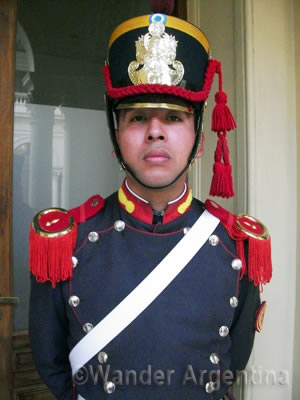

Highlights of the Casa Rosada
A stroll through the Casa Rosada offers visitors a peek into Argentina’s turbulent history and the wealth of the nation.
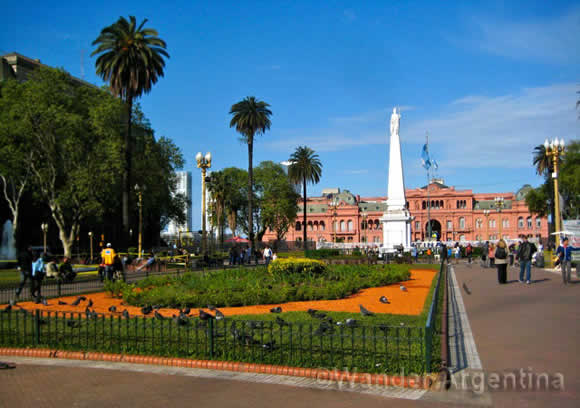
Visitors first get a glimpse of the Bicentennial Hall of Argentina Painters and Paintings, inaugurated in 2011.
From there it’s onto the rest of the palace including the Salón Blanco (White Room), where many important presidential ceremonies take place, the Martín Fierro Hall, more luxurious halls and stairs of Honor, and the beautiful stained-glass gallery.
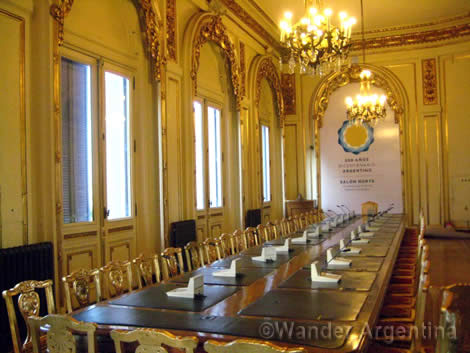
The Bicentennial Hall for Argentine Women is flanked by photos of famous women of Argentine history and is where in 2012 the Eva Perón 100-peso bill was introduced with much fanfare. Visitors also get a peak into the President’s office, the presidential elevator with its theater-like red velvet bench and the office where Eva Perón gathered her fervor before heading out to the balcony to address the descamisados (‘shirtless ones’).
Toward the end of the tour, visitors pass over the Patio of Honor, or the Patio of the Palms, which looks as if it came out of a 19th-century Spanish film.
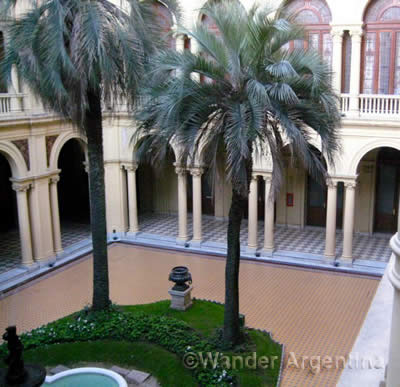
If you linger too long in any room, marveling at sparkling chandeliers or turn of the 19th-century furniture, a guard or security officer will shoo you along to catch up with the group.
The presidential balcony is the highlight of the tour for many, as it’s a chance to take the stage where former presidents have given historic speeches, get a bird’s eye view of Plaza de Mayo and get a great picture to take home.
Free Tours of the Casa Rosada
Guarded by police and tall gates often flanked with protest signs, the Pink House appears to be an impenetrable castle.
But every weekend, the mysterious palace doors open to the public for free hour-long tours.
The entrance for the tour is at the northern backside of the building, facing Plaza de Mayo.
Once you fly past the lax security and metal detector, make sure to take a photo with the guards of honor, and perhaps try to get them to crack a smile, before getting in line for a ticket.
The Casa Rosada tour is on a first-come, first-served basis and you need the colored ticket to be placed in a tour group.
The tours are available in Spanish, English and Portuguese, although unless you are with a large group of foreigners and request a language preference beforehand, it will most likely be in Spanish.
Your tour guide will probably be bilingual and can fill you in on the side though.
—Rachel Aretakis
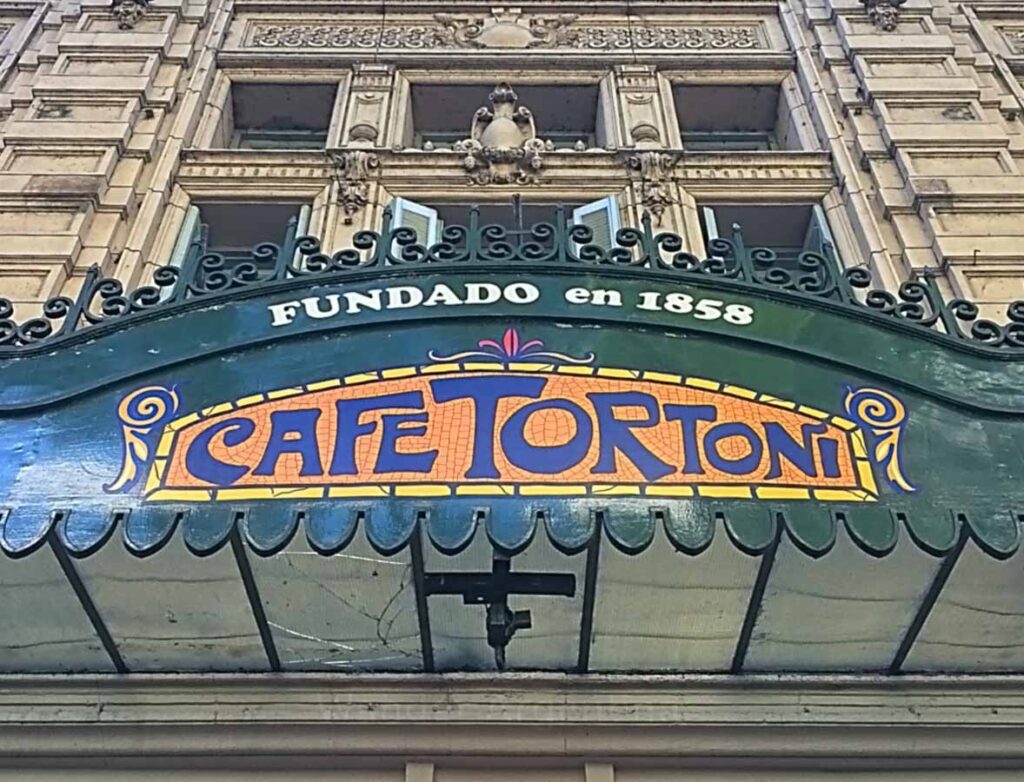
Nearby, check out the Cafe Tortoní, a historic French style café ➡
Tours of the Casa Rosada 50 Balcarce, Mirocentro Tel: 4344-3802 / 4344-3805
* Editor’s Update: Until the last change of administration in Argentina, guests could make free reservations through https://visitas.casarosada.gob.ar/ but the website isn’t working.
In the meantime, check out some other popular Buenos Aires tours .
• When operating (up in the air due to the pandemic) 10:00 a.m. until 6:00p.m., Saturdays (in Spanish) They begin every 10 to 15 minutes and last about an hour, they are now required to be booked online via the link above
• English tours are on Saturdays at 12:30 p.m. The website says you must book 15 days in advance and sometimes is full. If this is the case, you can just try to show up at the right time and you may get lucky. Make sure you have your passport. • Cost: Free! • Cameras are permitted on the tour, but no flash • ID may be requested for security reasons
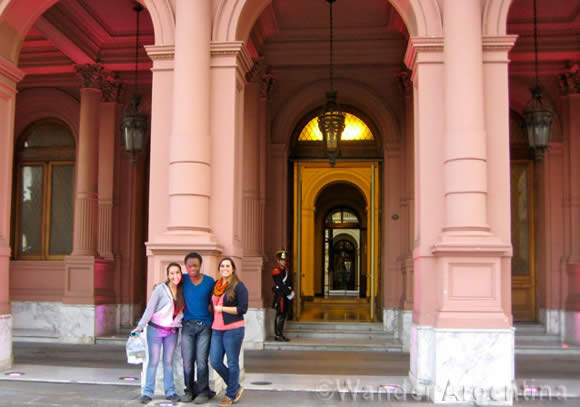
→ For even more Argentine history, visit the Casa Rosada Museum (formerly the Bicentenary Museum), on the south side of the first floor.
It offers over 200 years of governmental mementos, a look at the city’s underground tunnels and fort on top of which the Casa Rosada was constructed as well as permanent and temporary art exhibits.
Buenos Aires Downtown Tours & Day Trips
→ Check out our tour page for a curated list of Buenos Aires City Tours
→ Book a Private Half-Day Buenos Aires City Tour — A four-hour private Buenos Aires tour with a knowledgeable expat resident.
This full-service tour can be personalized to see the Buenos Aires’ highlights such as the La Boca, the Plaza de Mayo, San Telmo and Recoleta , including the Recoleta Cemetery , depending on your preference.
→ Read about Tango Shows & Activities in Buenos Aires
1 thought on “Casa Rosada: Argentina’s Pink Government House”
- Pingback: A Good Week | A Far Piece
Comments are closed.
Our Services
Privacy Policy
Airport Pickup
Attend a Soccer Game
Book Accommodation
Driving & Car Rental
©Wander Argentina 2024
All rights reserved.
As Amazon Associates, Wander Argentina earns from qualifying purchases

Visit Casa Rosada “Presidential Palace” for free
The presidential executive office or better known as “Casa Rosada” is located at Plaza de Mayo in the heart of Buenos Aires. The pink color of the palace gives it a remarkable look. But, did you know that you can visit Casa Rosada? And for free? A hidden secret for many.
Read also: hop on hop off bus in Buenos Aires. Worth the money?
Visit Casa Rosada in Buenos Aires
Visiting a presidential palace has something unique and the guides of Buenos Aires know that, and hereby the available spaces are fast occupied. The tours in Casa Rosada are guided and with timeslots. A tour takes around 1h. We give you the best tips on how to get access.
How to get an entrance ticket?
The Casa Rosada is open for the public every Saturday. However, registration before is obligatory. The registration always starts two weeks before the actual visit date. Meaning, you want to visit Casa Rosada on January 14th? Then the registration will be open on January 1st. Follow this link. (UPDATE: the link is currently not working. I’m waiting for an answer of Casa Rosada)
English guided tours are always at 12h30 and the spaces are limited. If you want to follow the tour in Spanish, then you have more options.
An overview of how to get your free ticket:
- Two weeks before visiting the registration opens. This link .
- Tours only on Saturdays. English tour at 12h30.
- Registrate with your passport! Based on your passport they will do a check in the police databases.
- Print your tickets.
- Bring your passport when you go to visit Casa Rosada. No access without a passport.
What makes it special?
The presidential palace has a rich history. Before the Casa Rosada, there was the Fort of Juan Baltazar of Austria. The fort was demolished in 1857 and the palace was constructed in the same place.
The Casa Rosada has beautiful rooms with influences from all over the world. Also, the famous balcony of Eva Duarte Perón is open to visitors. In the meantime, you get a look where the president works and meetings are taken place with presidents from other countries. Definitely worth a visit Casa Rosada.
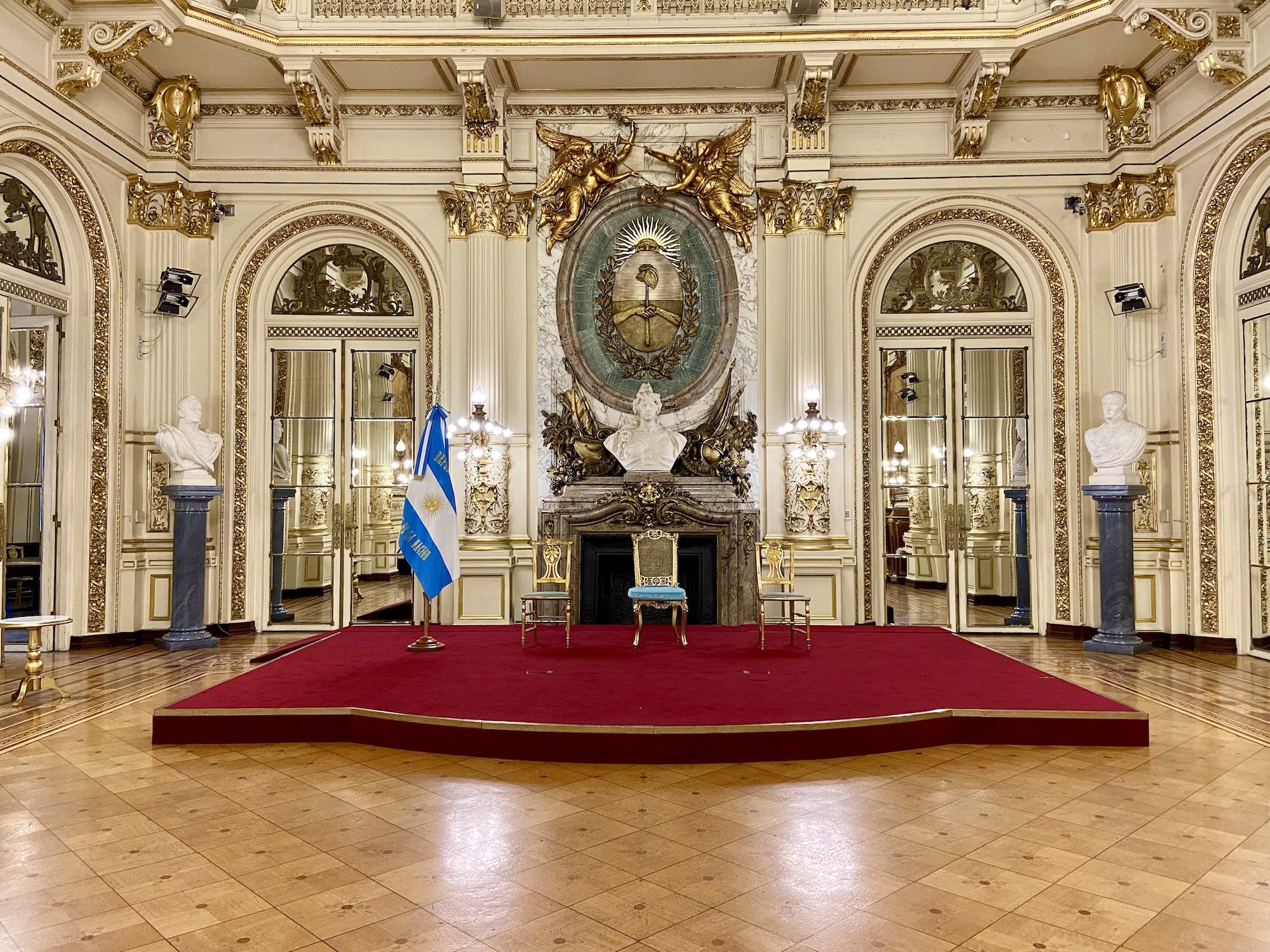
My roots in Buenos Aires started as a tourist. After some great adventures in Argentina, I moved in 2017 to the metropolitan city of Buenos Aires. I felt a need for correct and honest information for tourists. That's why I love to write to you. Sharing my discoveries in Buenos Aires. I hope you enjoy the city as much as I do! Buenos Aires ❤️
Related Posts
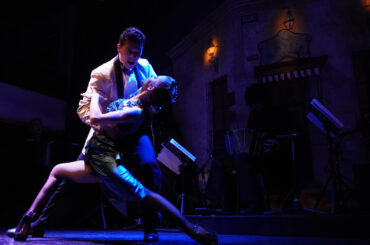
Best tango show in Buenos Aires
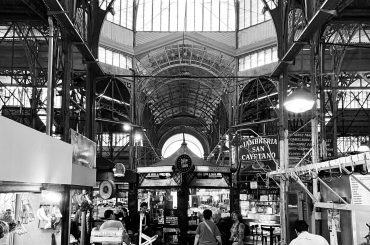
San Telmo market: everything you need to know
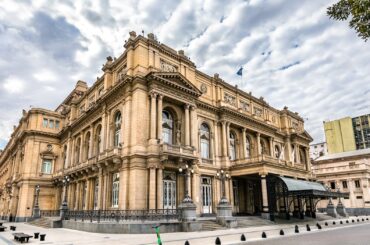
Visit Teatro Colón in Buenos Aires: how to get tickets
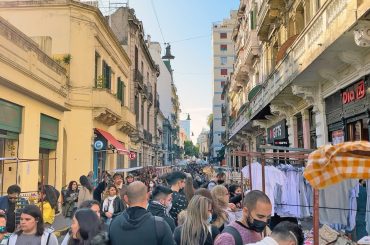
Things to do in Buenos Aires on Sunday
10 comments.
Hi Glenn, do you know if the Saturday tours been discontinued? The link to make reservations is not working for me. Or do you know if we can make reservations directly at Casa Rosada on the day itself. Thanks.
Hi Glenn, do you know if they still have tours of Casa Rosada every Saturday. The website I have doesn’t work: https://visitas.casarosada.gob.ar/ . Do you know if there is another way to make a reservation. Thanks.
Hi Murad, Unfortunately there are no tours at Casa Rosada anymore until further notice 🙁
How do get tickets? We want to visit on Saturday, Jan. 28, 2023. We are available all day. Need English speaking guide. Thanks. Mark
Hi Mark, I don’t get an answer for the Presidential palace nor other organizations. I didn’t see tours starting anymore.
Hi Glen, the link is still not working 🙁 Do you know if there is any other way to book this tour?
Hi Natalia, I received a reply from the Presidential House today. They referred me to another e-mail address and there I received the answer that they do not organize this. I guess visits don’t go ahead. I continue to find the right contact.
Trying to follow the link to boo tickets for Casa Rosada tour, and looks like the link is not working?
You are right but it is still the correct link. Even from the official presidential website they refer to that website. I contacted them for more info but no answer yet.
What a beautiful palace. We were lucky that we could visit Casa Rosada just before the presidential inauguration in December. Definitly a secret in Buenos Aires.
Write A Comment Cancel Reply
Save my name, email, and website in this browser for the next time I comment.
- Airport Transfer
- Book Tango Show
- Follow Instagram

- Top Attractions
- See a Tango Show
- Best Day Trips
- Food and Drinks
- Hidden Secrets
- Itineraries and Walks
- Football Match tickets
- Travel Checklist
- Airports and airlines
- Exchange money
- Best Time to Visit
- Get a Sim Card
- Best Hotels
- Where to Stay
- Public transport and taxi
- History and Facts
- Cycling in Buenos Aires
- Christmas and New Year
- Patagonia travel tips
Visit to the Casa Rosada
A Solemn Building and Accessible To All On a sunny Sunday morning, once we got through the arcade on 50, Balcarce Street, City of Buenos Aires on the entrance of the Casa Rosada , a woman invited us to get inside the patio, the gathering place where visitors are ready to start the tour. “We are about to start the tour, please wait here. You may take some pictures with grenadiers, if you wish.” One by one and in a shy way, Argentinian people and foreigners started to stand up among the grenadiers while a friend, partner or a relative took the picture.
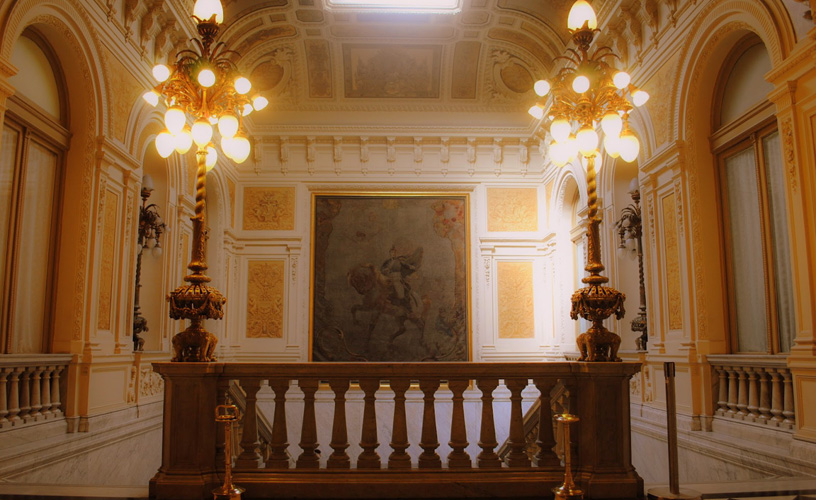
The magnificent Pink House
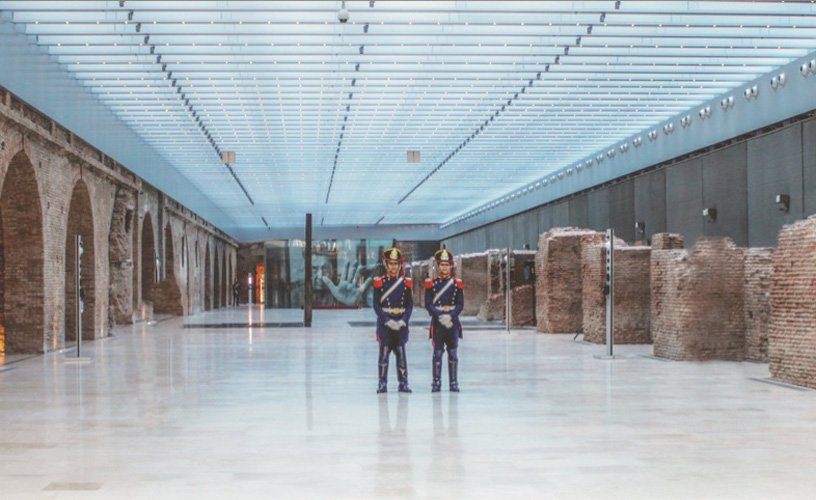
The remains of two historic buildings
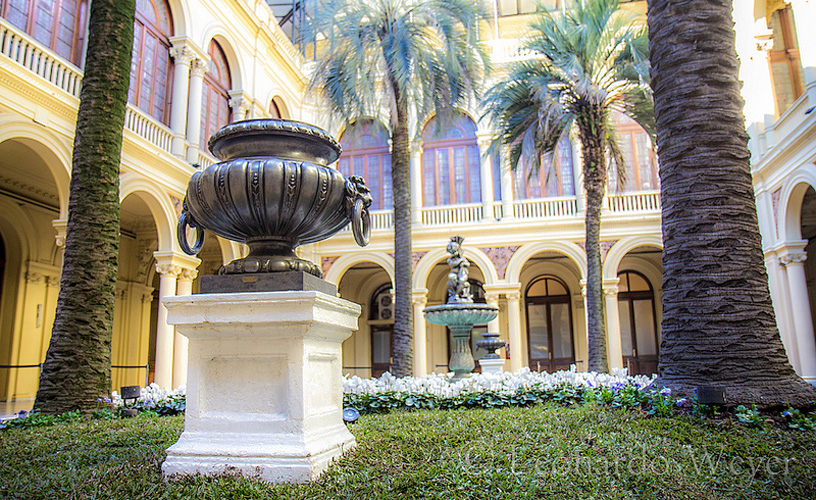
Palm Trees Patio
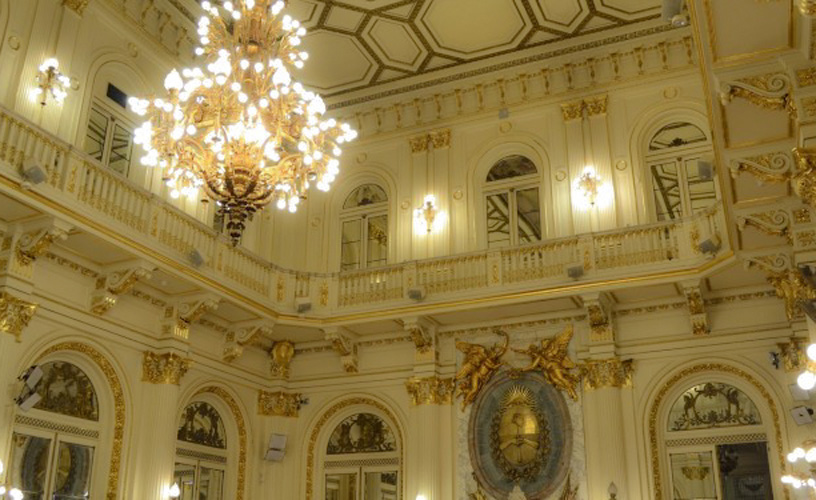
The White Room
Staircases, Hallways and Patios Once a reasonable number of visitors had gathered at the entrance, we started the tour. The grenadiers introduced themselves and explained to us where we were and the meaning of each room. In this way, we went past the staircases used by the press and the patio where a statue in homage to Manuel Belgrano stands. Steps forward, when the first grenadier left us and we went on with the second one, we arrived at the so-called Palm Trees Patio . This section of the Casa Rosada used to serve as the residence of the viceroys and it was in this patio where they welcomed their honorable visitors. The peaceful sound of the fountain made us think for a while about the Argentinian elite society of those times as the grenadier allowed us to take more pictures. The White Room Going up one of the staircases of honor, also known as the Italia Staircase, we reached the second floor, where we could visit the North, South and the White Rooms, used for all kinds of meetings. The White Room has been the customary place for presidents to hold the most important ceremonies; for instance, the ceremony by which the elected head of state holds office and receives the command attributes: the presidential sash and baton. As we stayed in these rooms, we were captivated not only by the magnificence of the building and distinctive decoration but also by the fact that we were in a place where the most historically significant events have occurred. Another staircase of honor led us to the first floor and from such section we headed towards what we thought was the starting point: The Honor Hall and the Gallery of Busts. This is the access point, where presidents and special guests enter the house. We took more pictures and immediately afterwards we got through the door. As we left behind the government house, we could not avoid the feeling that we had visited only a small part of this huge building. However, we knew that we had not visited a museum, which was probably the difference with the rest of our tours, that is, we did not visit a place where historical events are on display, but a place where history really happens.
- Most popular lodging options in Ciudad de Buenos Aires
- Lodging with a pool
- 3 star lodging
- 4 stars and over
- Lodging with SPA
- With free parking
- Pet-friendly
- 2 and 1-star lodging
- Only with published prices
- All Hotels in Buenos Aires
Things to do in Buenos Aires City

Buenos Aires by bicycle

Café Tortoni
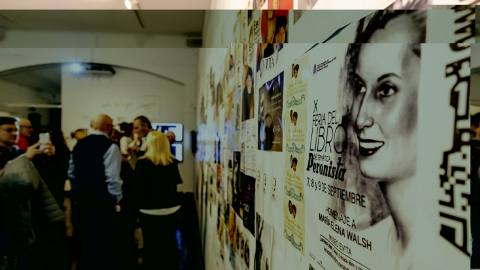
Evita Museum in Buenos Aires

What Things Were Like in 1810

Cemetery at Recoleta

The Metropolitan Museum

There is Only One Reconquista

A Tour around the Recoleta Cemetery

The City’s Museum

A Ride around Lezama Park

View more tours and activities
Hotels and accommodations in Buenos Aires City
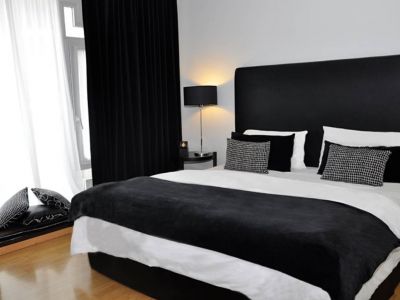
4-star Hotels
Broadway Hotel & Suites
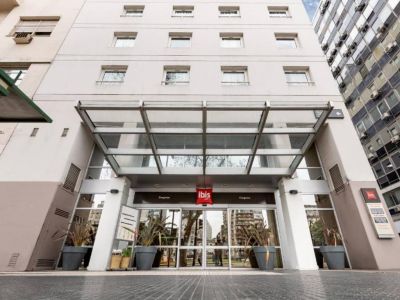
Ibis Buenos Aires Congreso
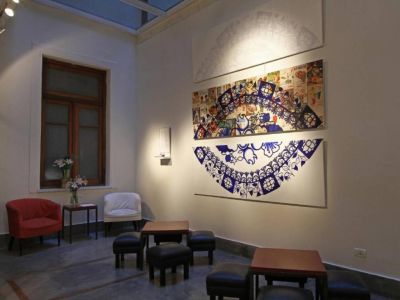
3-star Hotels
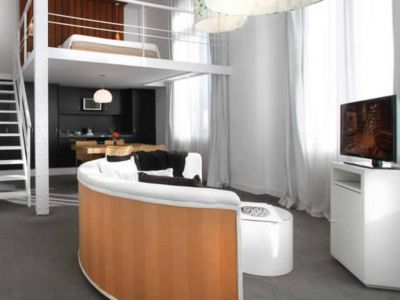
HTL 9 de Julio Bs. As.
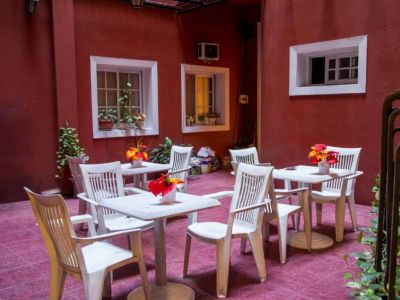
Hostel Estoril
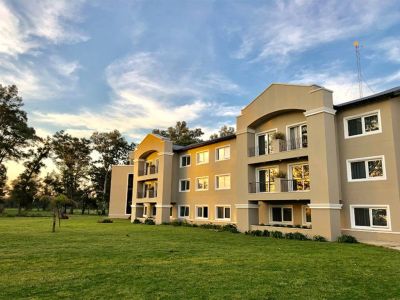
Howard Johnson Ezeiza
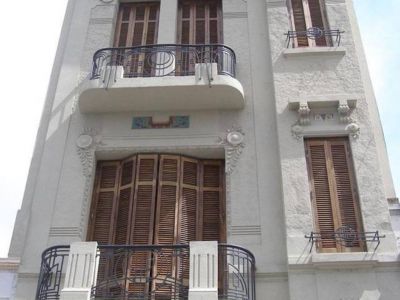
2-star Hotels
Viejo Telmo
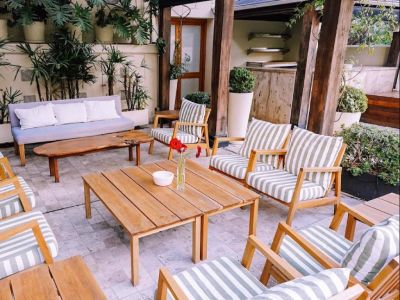
Hub Porteño
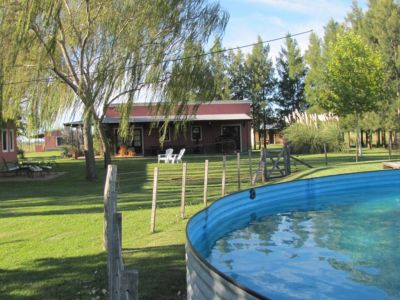
Lodging at Estancias
Finca La Paquita
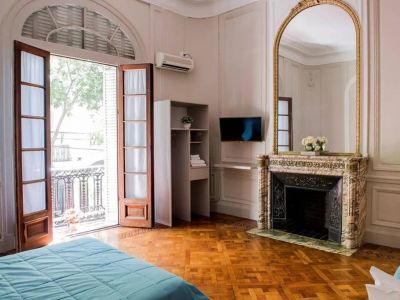
Patios de Recoleta
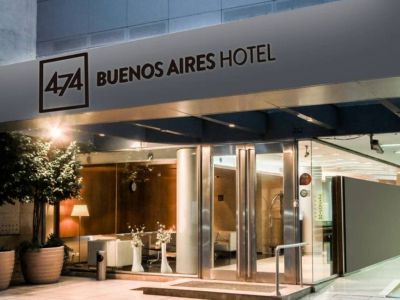
474 Buenos Aires Hotel
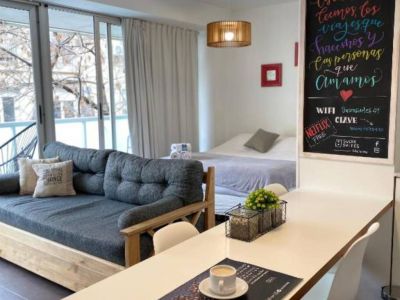
Sucre Suites
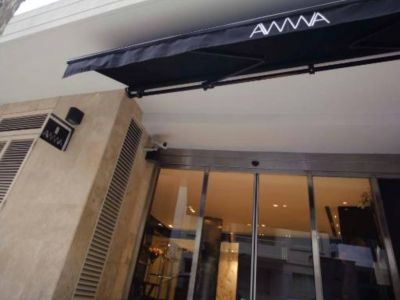
Awwa Suites & Spa
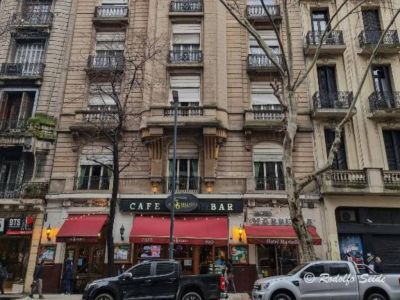
La Barca Hotel

Buenos Aires City
View more lodging
Terminos y condiciones
Tour of the Casa Rosada
The US might have the White House, but Argentina has the Pink House. The Casa Rosada at the eastern extreme of the Plaza de Mayo is the seat of the country’s government, where the President and her staff work. On weekends, you can tour the building for free.
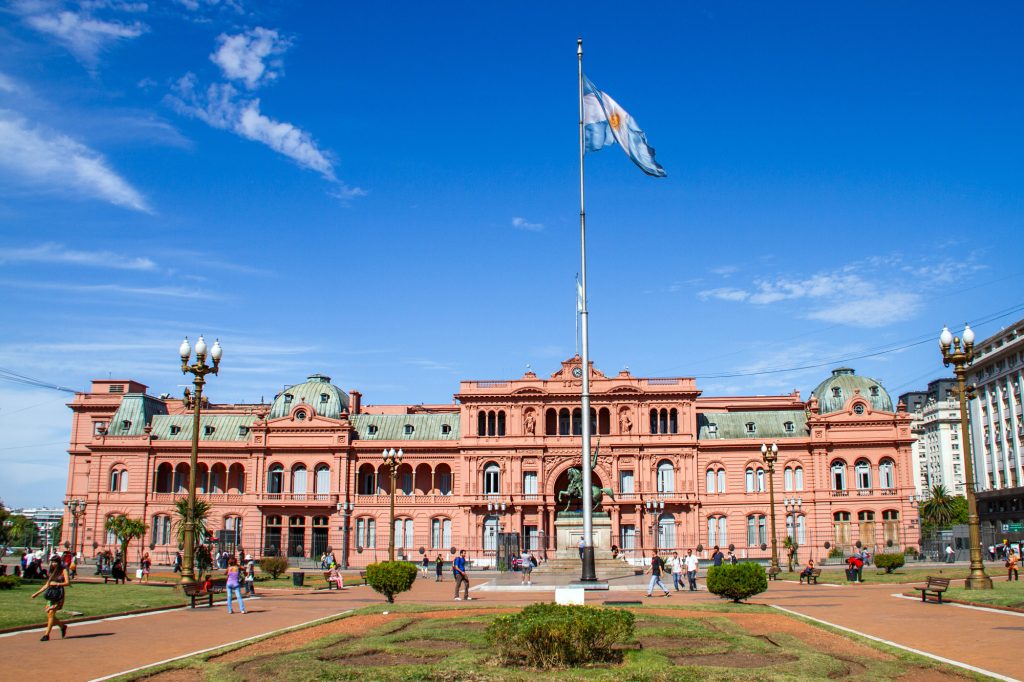
Unlike America’s White House, the President doesn’t live inside the Casa Rosada. But very much like America’s Jennifer Lopez, the building is most frequently photographed from behind. The front of the Casa Rosada faces towards Parque Colón, and people taking pictures from the Plaza de Mayo are actually admiring its boomin’ rear facade. The back balcony is where Eva Peron delivered her famous speeches.

Evita’s presence still looms large over the Casa Rosada, which is more correctly known as the Casa del Gobierno. Along with a huge group of about 60, mostly Argentinians, we were led the premises around by a decoratively outfitted soldier. There was a gallery of important South American leaders, a gorgeous courtyard with a fountain, classic artwork on the walls and stunning interior architecture. We were able to get out onto the balcony, and look out over the Plaza just as Evita once did. I’ll give you one guess what song I was humming . We were even allowed entrance into the President’s office.
The house’s strange color has a poetic meaning of its own. Pink was chosen as a way to soothe relations between rival political parties, by symbolically mixing their colors: red and white. It looks beautiful, particularly at dusk. The Casa Rosada has been the heart of Argentine politics since the country’s founding.
More Casa Rosada Photos:

- Post published: February 19, 2011
You Might Also Like
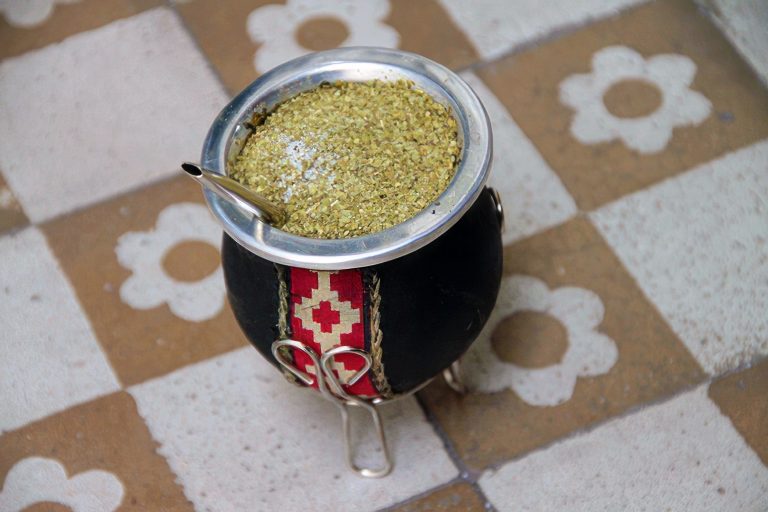
Crazy for Mate
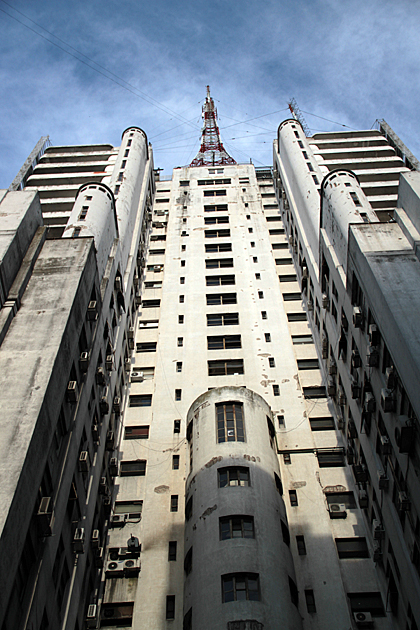
Metropolitan Buenos Aires
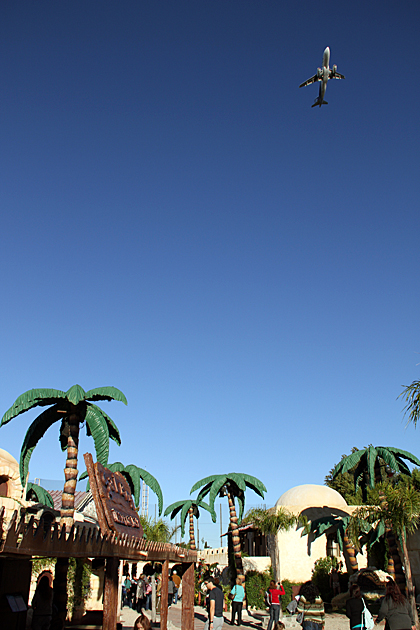
Tierra Santa … Holy Cow
This post has one comment.
Great pictures!! It’s great the pink house! Did you see the elevator? it’s a masterpiece!!
Leave a Reply Cancel reply
- South America
- 10 Things You Need To...
10 Things You Need to Know Before Visiting The Casa Rosada

The Casa Rosada, or the presidential palace, is one of the most emblematic buildings in the Argentine capital of Buenos Aires . Known for its unique pink colour, this palace has been at the focal point of much of Argentina ’s history. Here’s everything you need to know before visiting the Casa Rosada. Take a guided tour

One of the best ways to discover the secrets of the Casa Rosada is by taking a guided tour. Tours are offered in Spanish and English, are free of charge and can be reserved by visiting the website. An experienced guide will take you around the public areas of the presidential palace, and you can see the incredible architecture, patios and regal atmosphere of the house in all its glory on the inside. This is the executive mansion, not the official residence, of the president
The Casa Rosada is officially called the executive mansion of the president of Argentina, which is different to the official residence, which is the Quinta de Olivos in the upper class residential neighbourhood of Olivos, in the north of Buenos Aires just outside the capital. During Cristina Kirchner ’s term in office, it was common to see the presidential helicopter flying over the city, taking her from the Casa Rosada to the Quinta de Olivos. Only one president has actually lived in the Casa Rosada, and that was Roque Sáenz Peña, between 1910 and 1914. It is made up of lots of different buildings

As much as the Casa Rosada looks like a uniform construction, it is actually the result of an amalgamation of many existing buildings that were built on the site over the years. In the late 1500’s, what is now the Plaza de Mayo was declared the founding place of the city, and a fort was established where the Casa Rosada now stands. In the mid 1800’s, a British architect designed the Customs House to the rear of the fort, and in the late 1800’s the Post Office was built on a part where the old walls of the fort had been demolished. These buildings were eventually consolidated into the Casa Rosada at the very end of the 19th century. The site of the Casa Rosada used to be the river’s edge
Although there is a large swath of land between the Casa Rosada and the Rio de la Plata, originally the rear of the site actually went to the water’s edge. Buenos Aires is a city that turns its back on the river, and now the port regeneration development at Puerto Madero provides a buffer between the city and the river. The riverside location was why this site was chosen for the original Customs House, because all of the goods coming into the city were processed in this building. The palace’s famous colour has dubious origins

As with every good historical site, the Casa Rosada is full of legend and lore, and one of the most famous tales is about the iconic colour of the palace. One story goes that the facade was painted with cow’s blood instead of paint so that it would be resistant to Buenos Aires’ famous humidity. But it is more likely that the house was painted pink to try and diffuse political tensions at the time – the colours of opposing political parties were combined to make pink: the Federals used red, while the Unitarians used white. The Casa Rosada’s balcony has been the scene of many famous events
Eva and Juan Peron perhaps made the most use out of the Casa Rosada’s famous balcony, which overlooks the city’s main square, the Plaza de Mayo. They would address the masses in the 40’s and 50’s, and these speeches were immortalised by Madonna in the Hollywood movie Evita . More recently, Cristina Kirchner has held court from the balcony, and even new president Mauricio Macri has engaged in some dad dancing from this perch. There is a museum behind the palace

Become a Culture Tripper!
Sign up to our newsletter to save up to $1,200 on our unique trips..
See privacy policy .
Located behind the Casa Rosada is the Casa Rosada Museum, where you can see a wealth of presidential paraphernalia from past presidents and eras of Argentina democracy. The museum stands on the site of the original fort, and tells the story of Argentina from colonial times to the present day. One of the architects of the palace also designed the Teatro Colon
Buenos Aires in the 19th was a hotbed of development, the nascent city seeing a boom in construction, with many important administrative, civic and cultural institutions being built at this time. One of the architects involved in the construction and consolidation of the Post Office, fort and presidential palace buildings was Francesco Tamburini, who was also the principal architect of Buenos Aires’ famous opera house, the Teatro Colon. A statue of Christopher Columbus was replaced at the end of the Kirchner reign

A monument to Christopher Columbus had been located at the rear of the Casa Rosada, but was replaced by Cristina Kirchner towards the end of her term with a Bolivian freedom fighter, Juana Azurduy, a gift from Bolivian president Evo Morales in 2015. The replacement of the Columbus statue with a female guerrilla from Bolivia is a statement on the past and present of Latin America. It is the site of mass protests in the capital
If ever there is a protest in the capital of Buenos Aires, the Plaza de Mayo, the city’s main square in front of the Casa Rosada, is the destination for the manifestation. This is because the public want their voice to be heard by the president, so what better way to show the authorities that they mean business than by protesting outside the presidential palace. On the ground in the Plaza de Mayo, you can see the symbols of the headscarves of the Mothers and Grandmothers of the Plaza de Mayo , and there is a permanent encampment of veterans from the Malvinas, or Falklands, War, who are in constant protest against the state.
Culture Trip Summer Sale
Save up to $1,200 on our unique small-group trips! Limited spots.

- Post ID: 1721164
- Sponsored? No
- View Payload

12 Top Tourist Attractions & Places to Visit in Buenos Aires
Written by Bryan Dearsley Updated Dec 28, 2023 We may earn a commission from affiliate links ( )
Elegant yet always bustling, Buenos Aires encapsulates the very essence of Argentina. South America's second-largest city, Buenos Aires is the political, economic, and cultural capital of Argentina , as well as the gateway to the rest of this large nation.
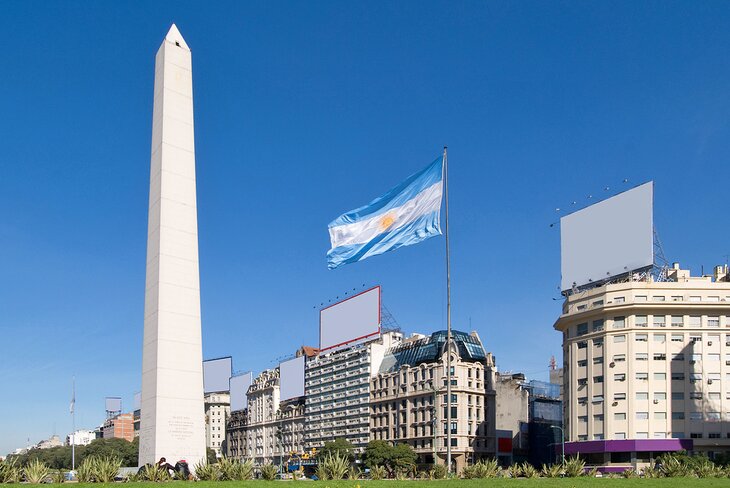
Its compact tree-lined center is reminiscent of Paris, with many charming corners where tidy high-rise apartments are interspersed with attractive 19th-century buildings. Most first-time visitors are surprised to find that this big city has managed to preserve its old traditions. Each of its 47 "barrios" boasts its own distinct character, and you'll never tire of exploring these delightful neighborhoods.
Among the most popular are Palermo, La Recoleta, and Belgrano, with their wide boulevards lined with palatial mansions, luxury high-rises, and large parks. Also fun to explore are San Telmo and La Boca with their distinctively colorful artistic flair, as well as trendy Puerto Madero and Calle Defensa.
In the downtown core, the Plaza de Mayo is the traditional focus of the city's entertainment and cultural activities and the best place to begin your exploration. Interested in shopping? Then make your way to Avenida Santa Fe, the city's most fashionable shopping area.
To learn more about these and other great places to visit in the Argentinian capital, be sure to read through this list of the top tourist attractions and things to do in Buenos Aires.
See also: Where to Stay in Buenos Aires
1. Explore Plaza de Mayo
2. tour the president's pink house: casa rosada, 3. a city of theaters: the colón theater, 4. visit the recoleta cemetery and museums, 5. explore la boca and the caminito street museum, 6. buenos aires cabildo, 7. san telmo and the national historical museum, 8. the metropolitan cathedral, 9. art galleries old and new, 10. palermo and jardín botánico, 11. the national museum of decorative art, 12. it doesn't take two to tango, where to stay in buenos aires for sightseeing, map of tourist attractions & things to do in buenos aires.
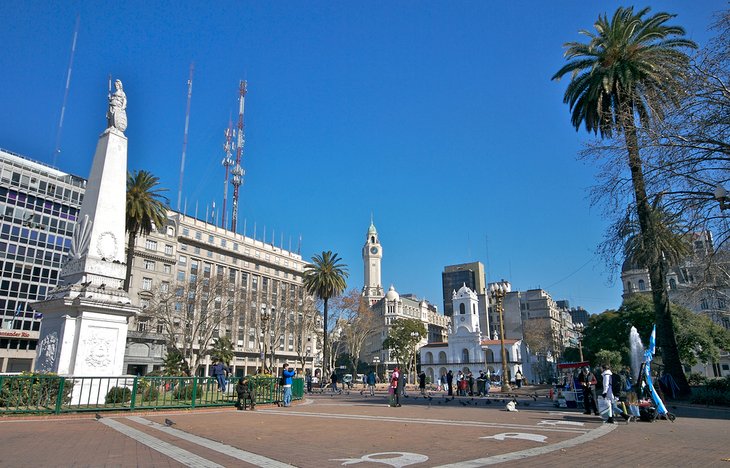
Buenos Aire's Belle Époque is evident in the splendid old colonial buildings found in Plaza de Mayo. Established in the 16th century and the country's oldest public square, this delightful two-block-long plaza has been the stage for many important events in the city's history.
Most notable among these were the uprising against Spain in 1810 and the continuing vigils held by the Madres de la Plaza de Mayo, or the Mothers of Plaza de Mayo, whose children "disappeared" during the military junta's reign from 1976 to 1983.
Much of the area is now entirely pedestrianized, including popular Florida and Lavalle Streets, and numerous attractions and things to do can easily be included in a fun walking tour of the area. As a result, Plaza de Mayo is the perfect place to begin your Buenos Aires sightseeing adventure, getting your bearings as you take in such important landmarks as Casa Rosada . This famous pale pink Presidential Palace was the place from which Eva Perón would address the enormous crowds eager to see her.
Also worth exploring is the splendid Avenida de Mayo . This splendid wide avenue is famous for its fine buildings with their attractive façades and domes, along with such landmarks as the famous Cafe Tortoni . Established in 1880, it's the city's oldest cafe and is considered the heart of tango. Also of note is the National Tango Academy (Academia Nacional del Tango de la República Argentina) located next door, which continues to welcome visitors.
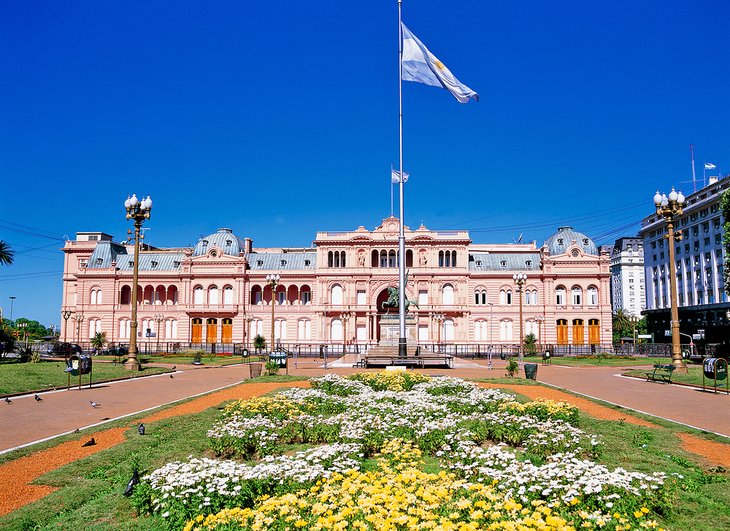
The most famous of Plaza de Mayo's many fine buildings, Casa Rosada was built in the mid-1800s and stands on a site known to have been occupied by an old customs house and fort dating back to the 16th century. Literally translated as the "Pink House," Casa Rosada — officially referred to as Casa de Gobierno or the government house — is the official residence of the President of Argentina.
Built in Italianate style, this fine mansion dominates the eastern end of the historic square, and makes for a splendid selfie backdrop. In addition to housing the President and state offices, this immense building is also home to the Casa Rosada Museum. Established in the 1950s, the museum's impressive collections include exhibits and artifacts dating back as far as colonial times when Spain ruled much of the continent.
Other notable highlights include murals by famed Mexican artist David Alfaro Siqueiros, painted in 1933 with assistance from some of Argentina's most prominent artists from that period. The museum is open Wednesdays to Sundays. Free English-language tours are available.
Address: Balcarce 50, Buenos Aires
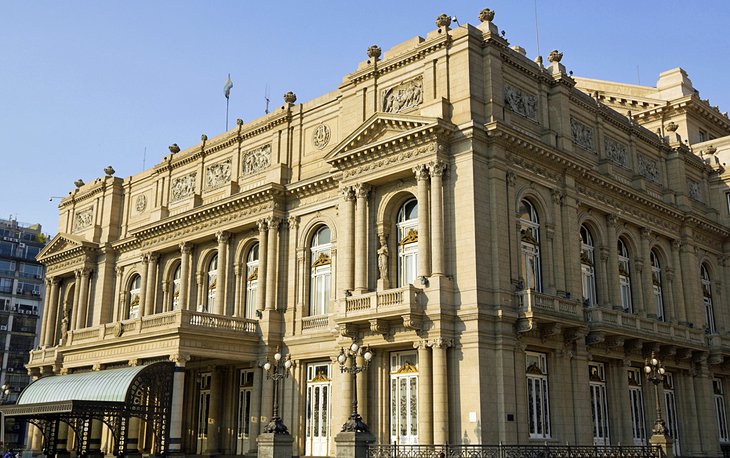
No lover of great theater or, for that matter, great theaters , should pass up the chance to visit Buenos Aires' many fine performance halls. Perhaps the best known is the stunning Colón Theater (Teatro Colón), a world-class opera, ballet, and classical music facility opened in 1908 that has hosted the likes of Callas, Toscanini, Stravinsky, Caruso, and Pavarotti.
Guided tours of the theater, considered to boast some of the world's best acoustics, provide a fascinating glimpse into the building's inner workings, from set-building to costume and wig-making. It's an experience that can only be topped by enjoying a performance in its sumptuous auditorium.
Other places of entertainment to visit include Teatro Gran Rex , a lovely Art Deco cinema opened in 1937, and Teatro Cervantes , home to the Buenos Aires National Theatre Museum with its displays relating to theater, film, and musical productions.
Address: Cerrito 628, Buenos Aires
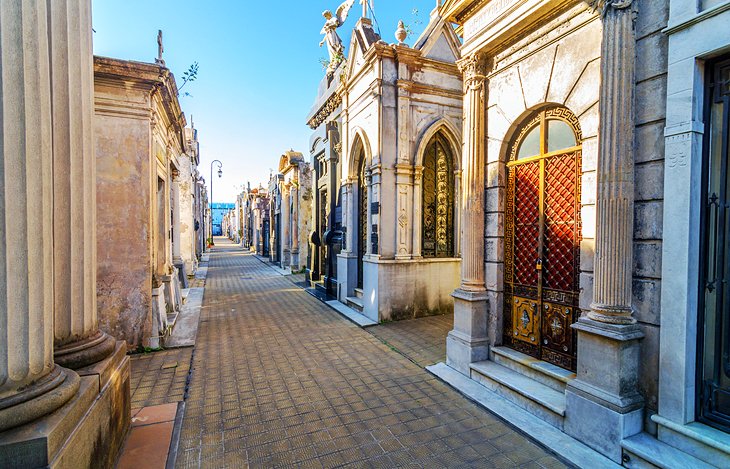
Fashionable Recoleta takes its name from the Franciscan convent that was built here around 1716, but is perhaps best known for its astonishing burial ground.
The Recoleta Cemetery (Cementerio de la Recoleta) has long been popular among locals and tourists alike, drawn here for the many elaborate mausoleums that serve as final resting places for a veritable Who's Who of famous Argentines, including such illustrious souls as Eva Perón, now embalmed in the Duarte family tomb.
Although somewhat ostentatious, these beautiful crypts are a testament to the national interest in death, something so important that Argentinians continue to honor their family members' birthdays and death-days alike.
Afterwards, be sure to explore the rest of Recoleta with its many public gardens, cafés, and craft shops, as well as other attractions, including the Museo de Arte Hispanoamericano Isaac Fernández Blanco with its extensive collection of colonial silver, wood carvings, paintings, and costumes, and the National Library where literary great Jorge Luis Borges served as director in the 1950s.
Address: Junín 1760, 1113 Buenos Aires
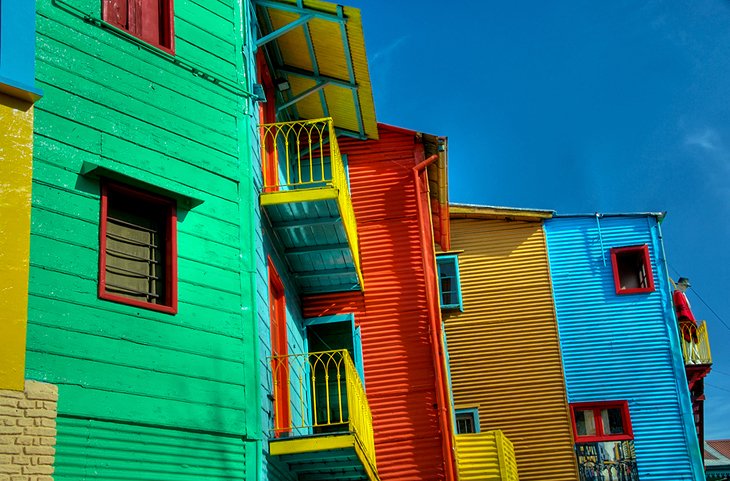
Undoubtedly Buenos Aires' most colorful neighborhood, and certainly one of the best places to visit if you want to grab some great photographs of authentic Argentina , La Boca is a favorite haunt for artistic and creative types. In fact, many of these same folk will take their art outside and onto the streets, decorating balconies and patios with amusing sculptures of tango dancers and other characters.
Much of the fun here for visitors is exploring the Caminito Street Museum , a colorful pedestrian-friendly zone that has functioned as an open-air museum and art market since 1959. Painted a patchwork of colors, this string of bright and extremely photogenic buildings offer quality crafts and souvenirs, sculptures, and, for the footloose, free open-air tango demonstrations (the area is in fact named after a tango).
A little more formal is the Quinquela Martín Museum of Fine Arts (Museo Benito Quinquela Martín) with its excellent collection of works by notable 20th-century Argentinian artists.
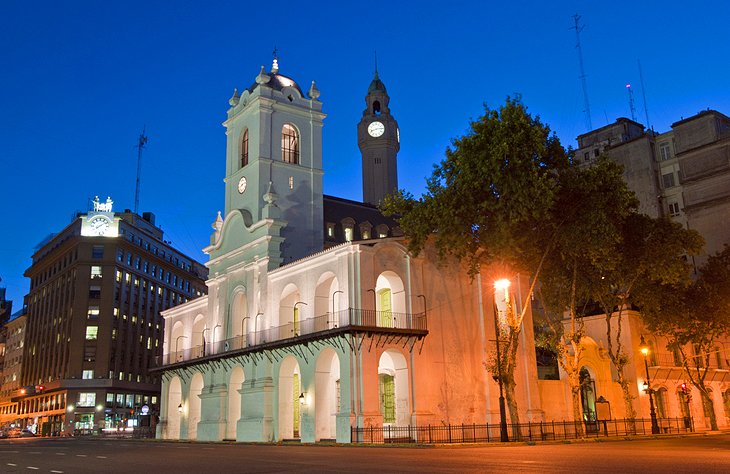
Located in Plaza de Mayo , the beautiful Cabildo served as the seat of the colonial government and was at the epicenter of the May 1810 revolution against Spanish rule. It dates back to 1610 and was later expanded throughout the 18th century.
These days this splendid building houses the National Museum of the Cabildo with its numerous exhibits relating to the city during the 18th century, including a replica of the city's first printing press, an exhibit of Jesuit and colonial art, and numerous old maps and photos of the city.
Another museum of interest in Plaza de Mayo is the Museo de la Casa de Gobierno. Located inside the Casa Rosada, the Presidential Palace, it provides a chronology of Argentinian presidents up to 1966 along with related artifacts and memorabilia.
Address: Bolívar 65, 1066 Buenos Aires
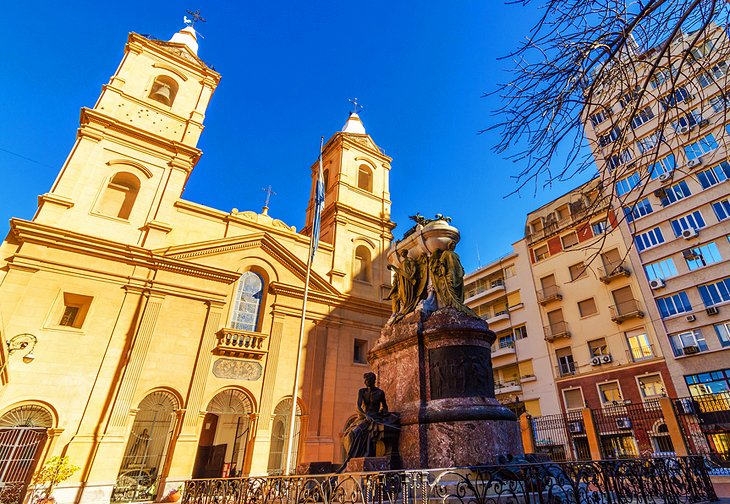
San Telmo is well known as one of Buenos Aires' more colorful districts, its narrow cobblestone streets and old colonial-style buildings home to numerous art studios and interesting galleries.
The area is also popular for its cafés, tango parlors, and boutique shops and is a delight to explore, particularly during the San Telmo Sunday Fair (Feria de San Telmo), an antiques fair that draws crowds of eager shoppers and sightseers alike.
The biggest attraction in San Telmo, though, is the excellent National Historical Museum (Museo Histórico Nacional) with its displays relating to the history of Argentina. All told, the museum houses more than 50,000 artifacts, the most important being its collection of paintings by Cándido López, a forerunner of contemporary primitive painting.
Another museum of interest is the Bernardino Rivadavia Natural Sciences Museum , opened in 1826 and now boasting 13 exhibition halls bursting with displays of Argentinian flora and fauna, along with an on-site aquarium.
Address: Defensa 1600, 1143 Buenos Aires
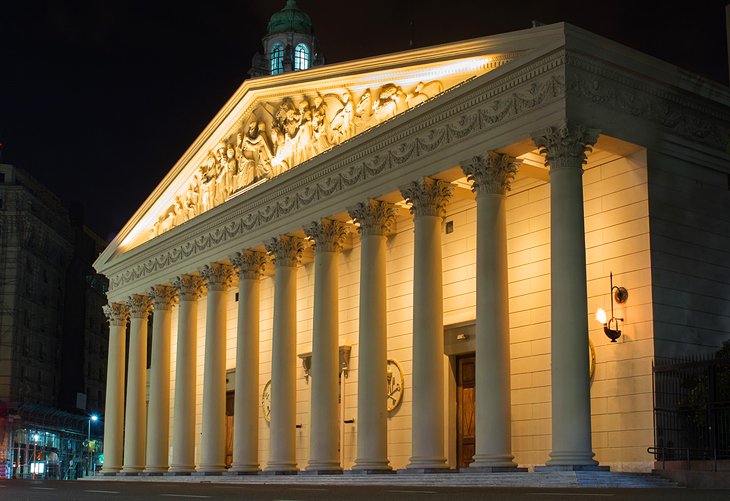
While construction of its Neoclassical façade wasn't initiated until 1822, Buenos Aires Metropolitan Cathedral (Catedral Metropolitana) overlooks Plaza de Mayo and can trace its roots back to the early 16th century when the Spanish established one of the country's first churches here.
Despite its rather plain exterior, this catholic church boasts a lovely Neo-Renaissance and Neo-Baroque interior along with numerous important artworks, including 18th-century altarpieces and statues. There's also a Walcker organ dating from 1871 that includes an impressive 3,500 pipes and is regarded as one of the finest of its kind. Also of interest here is the tomb of one of Argentina's most revered revolutionary heroes, General José de San Martín.
Another religious site worth seeing is the Block of Enlightenment (Manzana de las Luces). This city block is traditionally regarded as the historical center of learning and high culture in Buenos Aires. It includes the Colegio Nacional de Buenos Aires and San Ignacio Church , the city's oldest surviving church, famous for its tunnels and artwork.
Address: San Martín 27, Buenos Aires
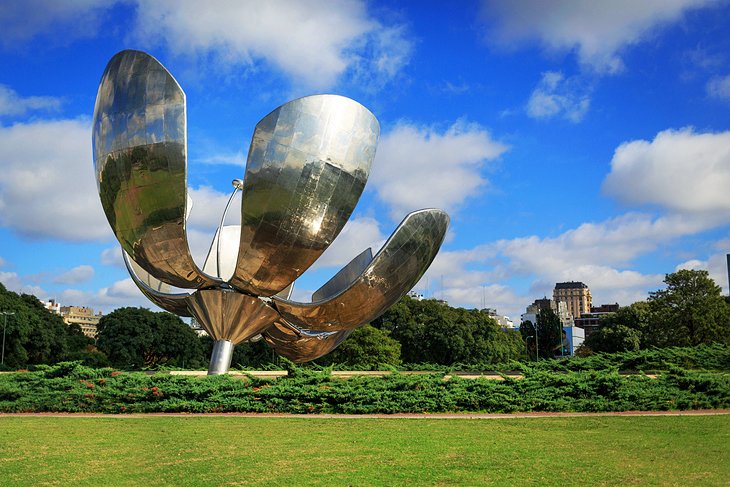
Buenos Aires has long had a reputation as one of South America's most significant centers for art. One of the newest and most impressive galleries is the Latin American Art Museum of Buenos Aires (MALBA) .
Housed in a superb modern building resembling a number of interlocking cubes, this world-class museum has numerous works by modern artists from across Latin America. It also serves as a cultural center showcasing the country's film and visual arts.
Also of importance to the art world is the splendid Buenos Aires Museum of Modern Art ( Museo de Arte Moderno de Buenos Aires ). Housed in a former tobacco warehouse, it's home to a collection of exhibits by local painters and sculptors along with permanent exhibits of local and international artists including Salvador Dali and Pablo Picasso.
Other galleries of note include the Museum of the Spanish Art of Enrique Larreta , with its impressive collection gathered by the famous writer, and the Fortabat Art Collection , a fine art gallery opened in 2008.
Be sure to also find time to visit the city's most interesting outdoor sculpture, Floralis Genérica. This massive steel and aluminum flower stands in the midst of Plaza de las Naciones Unidas, and even closes at night and emanates a pleasing red glow.
Address: Avenida Pres Figueroa Alcorta 3415, Buenos Aires
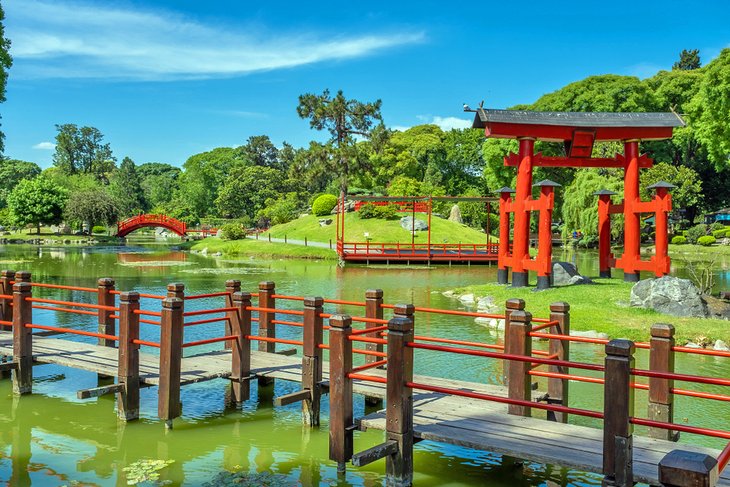
Palermo, the major recreational spot for Porteños, as residents of Buenos Aires are known, is where many of the city's largest and most popular parks lie. Once part of the estate of dictator Juan Manuel de Rosas, these days the area is home to a plethora of fine ethnic restaurants and Avant-garde fashion establishments.
It's here, too, that you'll find Jardín Botánico, the city's excellent botanic gardens with its numerous lakes, bridges, and sculptures spread across 20 acres of paradise. Established in 1898, the gardens boast some 5,000 flower species from around the world, including many from Argentina.
Highlights include such exquisite areas as the French and Italian Gardens, along with a herb museum and horticultural school. Also worth a visit are the Buenos Aires Japanese Gardens , the largest such garden in South America and popular for its bonsai collection, displays of traditional arts and crafts, and cultural center.
Address: 1425 Buenos Aires
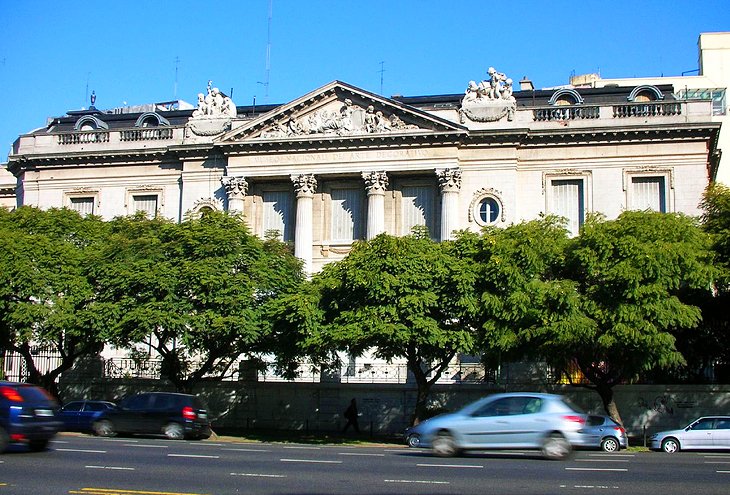
Opened in 1911 in the stunning Palacio Errázuriz , a landmark Classical French-style building in the heart of the Recoleta district , the excellent National Museum of Decorative Art (Museo Nacional de Arte Decorativo) is a must for art enthusiasts as well as those who enjoy great architecture. Highlights of the museum's collection include paintings by Spanish mannerists and French Impressionists plus Renaissance and Baroque furniture, tapestries, porcelain, and silver.
Also of interest and sharing the same building is the Oriental Art Museum (Museo de Arte Oriental) with its many fine displays of artwork from across Asia. Finally, art lovers should also check out the National Museum of Fine Arts with works by such European masters as Rodin, Renoir, Monet, and van Gogh, along with many important Argentinian artists.
Address: Avenida del Libertador 1902, 1425 Buenos Aires
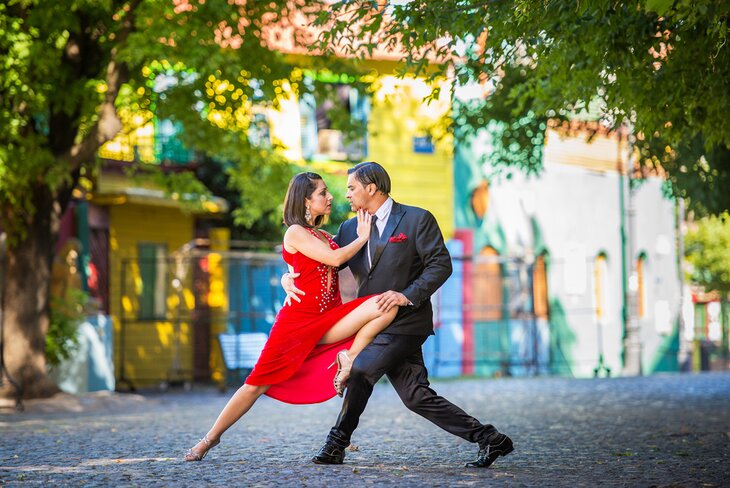
Whether you're traveling solo, with a partner, or as a family or group, you should definitely make time for a little tango in your Buenos Aires itinerary. Whether you're wanting to participate or merely observe, a variety of fun experiences are available that provide great introductions to this traditional Argentinian dance and art form.
One of the best is the La Ventana Tango Show with Optional Dinner . One of the city's most popular tango performances, the La Ventana tango show in the city's San Telmo neighborhood features live dancing and traditional Argentinian music with the option to add on a delicious three-course meal. Transportation from city hotels is included.
Another good option takes in the famous Teatro Astor Piazzolla . Your skip-the-line ticket includes a guaranteed spot for a performance at this gorgeous historic theater to witness traditional live music and dancing, with the option to add on a tasty Argentinian dinner.
We recommend these charming Buenos Aires hotels, with easy access to top sights like Plaza de Mayo, and chic neighborhoods like Palermo:
- Four Seasons Hotel Buenos Aires : This 5-star luxury, Belle Epoque mansion features marble bathrooms, a luxe spa, a heated pool, and sauna.
- Fierro Hotel Buenos Aires : This popular mid-range hotel features moderate pricing, a rooftop pool, rain showers, and an excellent restaurant.
- Mine Hotel Boutique : An affordable boutique hotel, Mine Hotel comes with a homey feel, outdoor pool, family rooms, and a fun tango show.
- Abode Buenos Aires : This budget-friendly B&B is located near excellent restaurants and boasts a sunny rooftop terrace.

More on Argentina
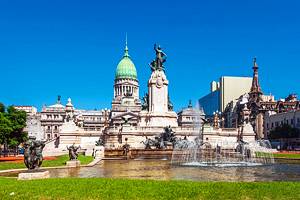

Sign Up Today
Start your 14 day free trial today

History Hit Story of England: Making of a Nation
Casa Rosada
Autonomous City of Buenos Aires, Autonomous City of Buenos Aires, Argentina
Casa Rosada is the presidential palace in Buenos Aires from which Eva Peron addressed the people.

Sarah Roller
24 nov 2020, @sarahroller8.

About Casa Rosada
Casa Rosada is a presidential palace in Argentina’s capital Buenos Aires. Literally translated as the “Pink Palace” due to its distinctive pink façade, Casa Rosada houses the executive branch of Argentina’s government.
History of Casa Rosada
The area on which Casa Rosada is located was once by the sea and in the late sixteenth century was the site of the Royal Fort of San Juan Baltasar de Austria built under the orders of Don Juan de Garay. It underwent a variety of changes: in 1713, the fort was demolished and rebuilt as the Castillo de San Miguel, the centre of colonial government. Following independence, architectural changes were made, but eventually the building was demolished in 1857 on the orders of President Justo José de Urquiza, who had the fort renovated which stood there, creating a customs house which would become Casa Rosada.
The Casa Rosada gets its name from the pink colour – legend says this was a political choice, a mixing of the red and white colours of the two opposing political parties at the time, but in all likelihood it was a practicality: white paint was often mixed with animal blood to help prevent the damaging effects of humidity. The design is known as Second Empire architecture.
The building was renovated and decorated in the 1860, first by Bartolomé Mitre and then by Domingo Sarmiento, transforming it into a presidential residence.
Probably the most famous aspect of Casa Rosada is its association with Eva Peron or “Evita”, the wife of President Juan Peron who addressed the people from its balcony in 1951, when the two ran on a joint President-Vice President ticket. Reportedly this was the largest public outpouring of support for any female figure in history.
Casa Rosada today
Casa Rosada is open to the public via pre-booked guided tour only: these operate at weekends, and you’ll need to bring ID to be admitted.
The Museo Casa Rosada is located behind the main palace, which houses exhibitions dedicated to Argentina’s political history – it’s a fascinating journey through several centuries of turmoil. There are also a selection of artefacts and restored murals by David Alfaro Siqueiros
Behind Casa Rosada are the little known 18th century catacombs of Fuerte Viejo, which are worth a visit.
Getting to Casa Rosada
Casa Rosada is on the east side of the Plaza de Mayo – the nearest metro station is Plaza de Mayo, and multiple bus routes stop on the square.
Featured In

Argentina Historic Sites
Discover the best Historic Sites in Argentina, from San Ignacio Mini to Nuestra Senora de Loreto.

Discover some of the most fascinating catacombs in the world, from subterranean crypts in Paris to Roman burial sites in Egypt, these eerie experiences are a unique way to explore the dark past of these cities.

Related Articles

Who Did the RAF Face in the Skies During the Battle of Britain?

10 Facts About the Battle of Gettysburg
Watch and listen.

Dambusters Special

Historical Dementia with David Andress
You may also like.

South America’s Best Historical Sites

10 of the World’s Most Beautiful Cemeteries to Visit

12 Eerie Cemeteries to Visit Around the World

Famous Historical Sites in Argentina

Cathedral of Córdoba

Basilica de Nuestra Senora Del Pilar

Catedral Metropolitana


Plaza de Mayo

La Recoleta Cemetery

San Ignacio Mini

Nuestra Señora de Loreto

Museo de la Mujer

Welsh Regional Historical Museum
- Skip to main content

- Home Buenos Aires
- Intensive Group Classes
- University Program
- Private One-on-One
- Private Group
- Argentina Study Visa
- TEFL Course
- Evening & Weekend Classes
- 1 Day Crash Course
- Classes for Kids & Families
- Spanish Classes
- Study Visa and Work Visa
- Learn Spanish in Mendoza
- Clases de Inglés
- Home Malaga
- Group Classes
- Private 1-on-1
- Spanish Study Visas
- Spanish for Seniors
- Kids Summer Camp
- Spanish for Kids
- Bildungsurlaub Course in Malaga
- Pricing Buenos Aires
- Pricing Málaga
- Pricing Online
- Spanish Students Visas
- 🇦🇷 🏡 Homestay in Buenos Aires
- 🇪🇸 🏡 Homestay in Málaga
- Private Apartment in Málaga
- Airport Transfer Buenos Aires
- Free Coworking in Malaga
- Workshops & Activities
- Volunteering in Buenos Aires
- Tango Classes
- Yoga Classes
- Why Spanish in Málaga
- Why Spanish in Argentina?
- 👨💼CORPORATE SPANISH
- 🚀 Ready to get started?
- 🎓 REGISTER NOW
- 📞 CONTACT US

- Społeczność
November 7, 2023 · Buenos Aires
Explore The Casa Rosada The Pink House: Argentina’s Icon
Send on WhatsApp
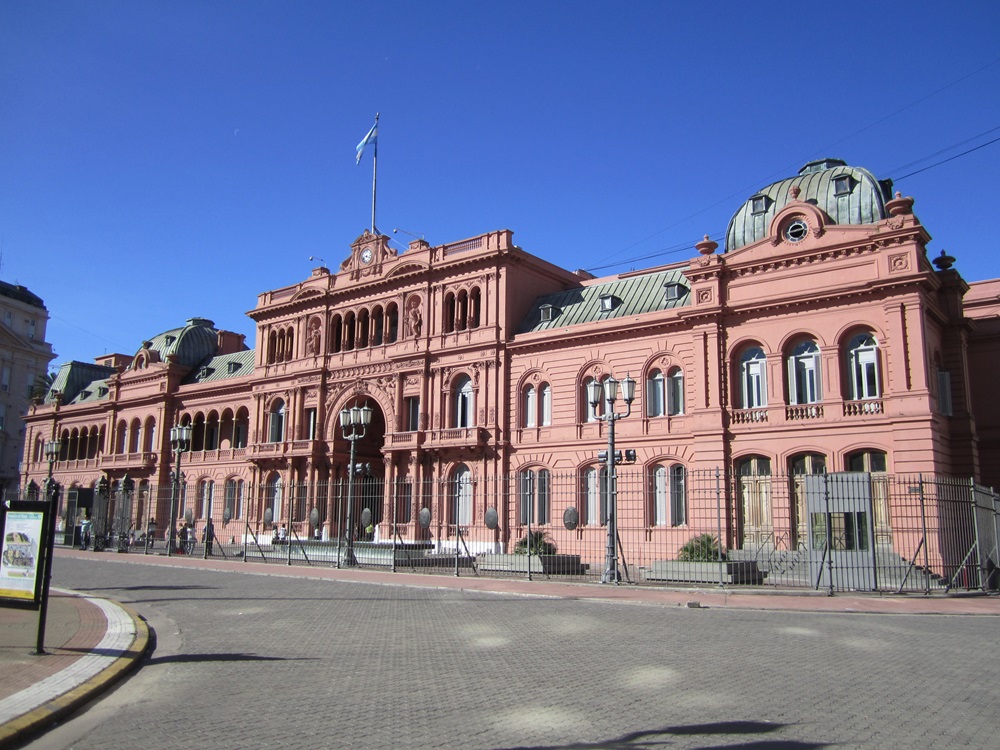
Welcome to the Casa Rosada, also known as the Pink House, a South American government headquarters and a prominent Buenos Aires landmark . This historical and iconic building is notable for its distinctive pink color and plays a significant role in Argentine politics. Let’s discover the fascinating history, architecture, and cultural significance of the Casa Rosada.
Key Takeaways:
- The Casa Rosada, also called the Pink House, is a historical and iconic landmark in Buenos Aires.
- It serves as the seat of the Argentine national government and is a symbol of Argentine politics .
- The Casa Rosada offers free guided tours in English and Spanish, allowing visitors to explore its rich history.
- The iconic pink color of the building has become synonymous with Argentine culture and heritage.
- The Plaza de Mayo , where the Casa Rosada is located, has been a site of significant historical events and protests.
History of the Casa Rosada
The Casa Rosada, with its historical architecture and status as the executive mansion and residence of Argentinian presidents, holds a fascinating history. The construction of the Casa Rosada began on the site of a Spanish fort established in 1580. Over the years, it underwent various transformations, including becoming a customs house designed by British architect Edward Taylor.
Also read about: Explore Buenos Aires Architecture on Bike – Your Next Adventure
In 1862, under President Bartolomé Mitre, the Casa Rosada officially became the seat of the Argentine government. Subsequent expansions took place, and it is believed that President Domingo Faustino Sarmiento ordered the building to be painted pink, giving it its distinctive color. The Casa Rosada has served as the residence of several Argentinian presidents and has witnessed numerous key moments in the country’s history.
The Evolution of the Casa Rosada
Throughout its existence, the Casa Rosada has undergone significant changes in its design and purpose. From its origins as a fort to its current role as the iconic symbol of Argentine politics , the building has stood the test of time. Each expansion and renovation has added to its architectural splendor, making it a sight to behold for visitors from around the world.
Also read about: Complete Guide to Argentina Congress in Buenos Aires
Casa Rosada’s Influence on Argentine Politics
The Casa Rosada has always been at the center of Argentine political power. As the official government headquarters, it has witnessed the rise and fall of leaders, the implementation of policies, and the staging ground for pivotal moments in the nation’s history. Its iconic pink color has become synonymous with Argentine politics, making it a significant cultural and historical landmark.
The Casa Rosada continues to play a vital role in the country’s political landscape, serving as the backdrop for presidential announcements and addresses to the public. The famous balcony speeches by Juan and Eva Perón during the mid-20th century cemented the Casa Rosada’s place in history and popular culture.
The Casa Rosada’s Significance
The Casa Rosada stands not only as an architectural marvel but also as a symbol of Argentine identity and heritage. From its humble beginnings as a fort to its transformation into the seat of government, it represents the resilience and determination of the Argentine people. Visiting the Casa Rosada offers a glimpse into the nation’s past and its ongoing journey as a democratic nation.
Visiting the Casa Rosada
The Casa Rosada, with its historical significance and vibrant pink façade, is a popular tourist attraction in Buenos Aires. If you’re planning a visit, here’s what you need to know.
Free Guided Tours
One of the best ways to explore the Casa Rosada is by taking advantage of the free guided tours offered. These tours provide insightful information about the building’s history, architecture, and political significance. Guided tours are available in both English and Spanish, allowing visitors to fully immerse themselves in the experience.
Looking to start intensive Spanish courses in Buenos Aires ?
To reserve a spot on a guided tour, simply visit the official Casa Rosada website. Keep in mind that it’s necessary to bring your passport for identification purposes. These tours provide a unique opportunity to learn about Argentina’s government headquarters and its role in shaping the nation’s history.
Casa Rosada Museum
Located behind the palace, the Casa Rosada Museum offers visitors the chance to delve deeper into Argentina’s rich heritage. The museum showcases exhibits that span from colonial times to the present, providing insight into the country’s cultural and political evolution. Entry to the museum is free, and it’s open on Wednesdays to Sundays, as well as on public holidays.
Inside the Casa Rosada Museum , you’ll find a variety of artifacts and displays that highlight key moments in Argentina’s history. From presidential memorabilia to exhibits on colonial times, the museum offers a comprehensive look at the country’s past. Don’t miss the opportunity to explore this immersive cultural experience during your visit to the Casa Rosada.
As you make your way through the Casa Rosada and its museum, you’ll gain a deeper understanding of Argentina’s vibrant history and its political significance. Whether you’re drawn to the iconic pink color, the architectural marvels, or the historical events that have taken place here, a visit to the Casa Rosada is a must for any traveler to Buenos Aires.
The Iconic Pink Color
The distinctive pink color of the Casa Rosada has become synonymous with Argentine politics and is a significant cultural heritage site . This iconic pink building stands out among the other structures in Buenos Aires, capturing the attention of locals and tourists alike.
Also read about: Independence Day of Argentina: The Heart of Cultural Pride
The exact origin of the pink color is a subject of debate and speculation. One theory suggests that the color was chosen as a way to diffuse political tensions by combining the colors of opposing political parties. Another theory suggests that the pink hue was achieved by using cows’ blood as an alternative to paint due to the high humidity in the area. Regardless of its origin, the pink color has become an integral part of the Casa Rosada’s identity.
As a symbol of Argentine politics , the Casa Rosada has witnessed countless significant events and protests throughout history. It has served as a backdrop for iconic moments, such as speeches delivered by Juan and Eva Perón from the balcony, as well as being a gathering place for political movements.
Table: Casa Rosada – Symbol of Argentine Politics
The Casa Rosada’s pink color continues to captivate visitors and serves as a constant reminder of Argentina’s political past. Exploring this iconic building and understanding its historical significance is a fascinating experience for anyone interested in the country’s culture and politics.

Architectural Features of the Casa Rosada:
Interesting trivia about the casa rosada.
The Casa Rosada, with its illustrious history and cultural significance, holds several interesting pieces of trivia that add to its allure. One fascinating fact is that Roque Sáenz Peña was the only president who actually lived in the Casa Rosada, residing there from 1910 to 1914. As the seat of the Argentine government, the Casa Rosada is an amalgamation of various buildings that were constructed on the site over the years. Originally a fort established by the Spanish, it later transformed into a customs house and was eventually expanded to become the presidential palace. This unique evolution of the Casa Rosada showcases the rich layers of history and architectural transformation that it embodies.
In addition to its historical significance, the Casa Rosada offers a glimpse into the construction techniques of its time. The building’s distinctive pink color, a symbol of Argentine politics, is not merely due to paint but is the result of a combination of materials and methods used during the construction. This intriguing blend of construction elements further adds to the Casa Rosada’s architectural charm and mystique. The Casa Rosada stands as a testament to the skill and creativity of the architects and builders involved in its creation, making it a fascinating subject for architectural enthusiasts.
Visitors to the Casa Rosada can explore its interior and discover the intricate details that make it a masterpiece of design and craftsmanship. From the Arch of Tamburini, crafted by Italian architect Francisco Tamburini, to the various rooms and halls that once housed Argentine presidents, every corner of the Casa Rosada exudes historical significance. The fusion of architectural styles and influences within the building reflects the evolving nature of Argentine society and politics throughout the years. It is this blend of history, architecture, and cultural heritage that makes the Casa Rosada a must-visit destination for anyone seeking a deeper understanding of Argentina’s past and present.
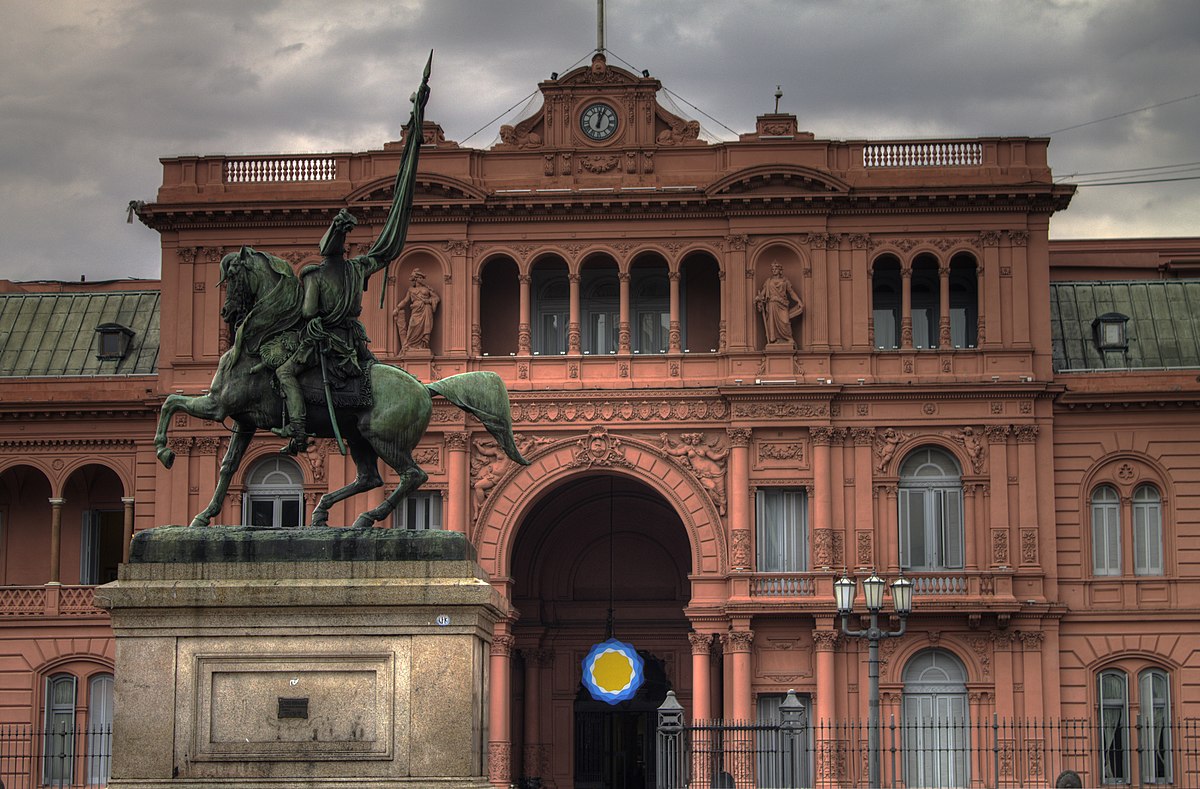
Construction of the Casa Rosada
The construction of the Casa Rosada is a testament to the evolution of Argentine architecture and the country’s political history. The building’s origins as a fort under Spanish rule, followed by its transformation into a customs house, and ultimately its expansion to become the presidential palace, represent different phases in the nation’s development. Each stage of construction showcases the architectural styles and influences prevalent during that period, offering insight into the changing face of Buenos Aires and Argentina as a whole.
The Casa Rosada Museum
The Casa Rosada Museum , located behind the palace, offers visitors a fascinating glimpse into Argentina’s past through its collection of presidential memorabilia and exhibits showcasing the country’s colonial history. The museum serves as a cultural repository, preserving and presenting artifacts that shed light on Argentina’s rich heritage.
Step into the museum and you’ll be greeted by a diverse range of exhibits that chronicle the country’s historical narrative. From colonial artifacts to personal belongings of past presidents, the Casa Rosada Museum provides a unique opportunity to delve into Argentina’s political and social history.
One of the highlights of the museum is a mural created by Mexican artist David Alfaro Siquieros. This magnificent artwork depicts important scenes from Argentine history, capturing the spirit and struggles of the nation. As you explore the museum, you’ll also come across interactive displays and informative panels that provide further insights into Argentina’s colonial past and the impact of its presidents on the country’s development.
The Casa Rosada Museum, located behind the palace, offers visitors a fascinating glimpse into Argentina’s past through its collection of presidential memorabilia and exhibits showcasing the country’s colonial history. The museum serves as a cultural repository, preserving and presenting artifacts that shed light on Argentina’s rich heritage.
Visiting the Casa Rosada Museum is a captivating journey through Argentina’s history. Whether you’re a history enthusiast, a political buff, or simply curious about the country’s past, this museum provides a comprehensive and immersive experience that shouldn’t be missed.
The Plaza de Mayo is not only visually stunning but also holds a deep historical and political significance for Argentina. It has been a site of mass protests and symbolic gatherings , providing a platform for the public to express their opinions and demands to the government. Over the years, the plaza has witnessed protests by various groups, including the Mothers and Grandmothers of the Plaza de Mayo, veterans of the Malvinas War, and other political movements.
Surrounding the Casa Rosada and Plaza de Mayo are other architectural marvels such as the Cabildo, a historic government building, the May Pyramid, a monument commemorating the May Revolution, and the Metropolitan Cathedral of Buenos Aires. These landmarks collectively create a vibrant and culturally significant area that showcases the city’s heritage and historical importance.
Plaza de Mayo and its Historical Significance
The Plaza de Mayo has played a crucial role in Argentina’s history, serving as a central gathering place for important events and movements. It became the epicenter of political activism during the Dirty War, as the Mothers and Grandmothers of the Plaza de Mayo protested against the disappearance of their loved ones. These brave women demanded justice and accountability from the government, leaving an indelible mark on the country’s collective memory.
Today, the Plaza de Mayo continues to be a symbol of resilience and civic engagement, reminding visitors of Argentina’s complex past and the ongoing struggle for social justice. It is a place where history comes alive, inviting both locals and tourists to reflect on the country’s turbulent past and its aspirations for a better future.
Protest and Political Significance
The Plaza de Mayo, with the Casa Rosada as its backdrop, holds immense political and historical significance in Buenos Aires. It has been a site of mass protests and symbolic gatherings for decades, serving as a powerful platform for the public to voice their opinions and demands to the government. The plaza has witnessed countless demonstrations by various groups, including the renowned Mothers and Grandmothers of the Plaza de Mayo, veterans of the Malvinas, and other political movements.
Do you want to learn Spanish? Best Spanish schools in Malaga
The mass protests held in the Plaza de Mayo reflect the deeply ingrained spirit of activism and political engagement in Argentina. The open space in front of the Casa Rosada provides a rallying point for individuals and groups to come together and express their concerns, advocating for social justice, human rights, and political change. The plaza has become a symbol of resistance and resilience, representing the unwavering determination of the Argentine people to fight for their rights.
The Plaza de Mayo has seen historic moments of unity and dissent, as well as the mobilization of social movements that have shaped the course of Argentine history. Whether it be demanding justice for the victims of human rights abuses during the Dirty War or advocating for economic reforms, the plaza remains a significant platform for political expression and civic engagement. It embodies the collective struggle for a more equitable and democratic Argentina.
Examples of Significant Protests and Gatherings
These examples represent just a fraction of the significant protests and gatherings that have taken place in the Plaza de Mayo. Each event has contributed to the ongoing dialogue and activism in Argentina, serving as powerful reminders of the country’s complex political landscape and the resilience of its people.
The Casa Rosada, with its rich history, iconic pink color, and significant role in Argentine politics, stands as a symbol of the country’s cultural heritage. This South American government headquarters has been the residence of many Argentinian presidents and has witnessed countless historical events.
Visiting the Casa Rosada is a must for any tourist in Buenos Aires. The free guided tours provide a fascinating insight into the building’s history and its impact on Argentine politics. In addition, the Casa Rosada Museum offers an opportunity to delve deeper into Argentina’s colonial past and explore presidential memorabilia.
Located in the historic Plaza de Mayo, the Casa Rosada not only offers architectural beauty but also represents a space where the public can voice their opinions and gather for protests. The plaza has seen significant political movements and serves as a reminder of Argentina’s fight for justice and democracy.
By exploring the Casa Rosada and its surroundings, visitors gain a unique understanding of Argentina’s past and present. Whether it’s admiring the architectural charm, learning about the country’s history in the museum, or witnessing a political gathering in Plaza de Mayo, the Casa Rosada offers an enriching experience for all who visit.
Special Promotion on our Online Group and Individual Classes!
Can't travel to us? No problem. We can bring you the same Spanish learning experience online and at a SPECIAL PRICE!
- 10-hr weekly group classes - ONLY AT $99/WEEK
- Personalized one-on-one classes - ONLY AT $20/HR
Sign up is easy. Just tell us what you're interested in and we'll get you started in no time.
I WANT TO LEARN SPANISH ONLINE IN*:
- GROUP CLASSES
- PRIVATE CLASSES
- First Name *
- Last Name *
- Email This field is for validation purposes and should be left unchanged.
Tagged: Discover Buenos Aires , Pink House , tourist
Share this post!
Join the conversation on social:
RELATED ARTICLES:
Saber and conocer explained: the how, why, when, and where guide.
Saber vs Conocer – How and When to Use Them Have you ever done…
Argentina National and Public Holidays Calendar 2024
One key holiday is May 25th, Argentina’s Independence Day, marking 202 years since freedom…
Vegan and Vegetarian in Buenos Aires. Our Guide to Food and Restaurants
In the land famed for its asado and tango, an astonishing 12% of residents…
Top 6 Best Things to See and Do in Argentina
Argentina presents an unmatched blend of natural wonders and cultural depth, beckoning adventurers and…
SPANISH CLASSES: BEGINNER TO ADVANCE. START TODAY!
- ONLINE SPANISH CLASSES
- LEARN SPANISH IN ARGENTINA
- LEARN SPANISH IN SPAIN
- ENROL TODAY
HIGHLY RATED & REVIEWED

TripAdvisor
HALL OF FAME
I took a four-week course at Vamos and was delighted with the experience. The course is conversation-intensive, which was incredibly useful given that speaking tends to be the most difficult skill.
Vamos Spanish Academy offers an outstanding educational experience. I spent a total of 12 exceptional weeks at the school.
I can also recommend highly the home stay feature of the course. I stayed with an Argentinian in the next suburb who only spoke Spanish, but who was very patient with me as I improved.
My Spanish improves by the hour! The staff and academic director do everything in their power to make your stay as comfortable as possible.
- Français ( French )
- Português ( Portuguese (Brazil) )
Casa Rosada
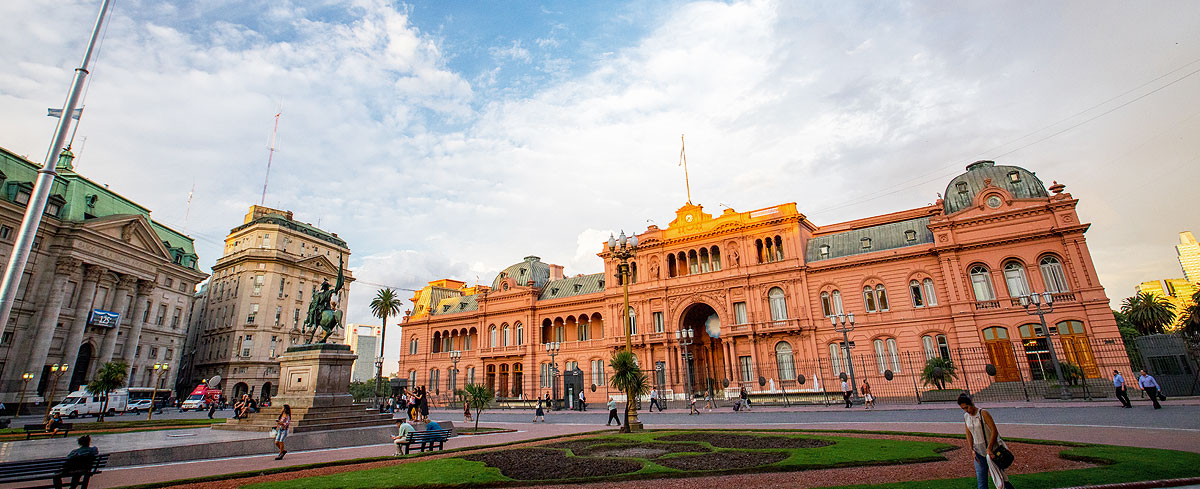
Present in tours
Dominating the Plaza de Mayo, the Casa Rosada - or pink house - is the seat of the Argentine national government and houses the president's office.
Witness to much of the city's history, it was from the balconies of the Casa Rosada that Juan and “Evita” Perón addressed the masses during the late 1940s and early 1950s.
The Casa Rosada was constructed on the site of a fort established by the Spanish in 1580 and used by the Spanish colonial viceroys. After independence, the fort was redeveloped into a customs house by British architect Edward Taylor, and later, in 1862, the building was chosen by President Bartolomé Mitre to be the seat of his government. His successor Domingo Faustino Sarmiento later expanded the building and is believed to have ordered it to be painted pink in an attempt to diffuse political tensions by mixing the colours of the opposing political parties (the Federals used red, while the Unitarians used white). Another popular explanation for the building's distinctive colour is that it was at one painted with cows' blood as an alternative to paint because paint pealed in the humidity.
The central archway was designed by Italian architect Francisco Tamburini, who was also responsible for the original design of the Colón Theatre, and was completed in 1890.
The only president to live in the Casa Rosada was Roque Sáenz Peña, between 1910 and 1914.
BALCARCE 50
casarosada.gob.ar
Check our articles for The Pink House in Buenos Aires, Argentina. All the information and our recommendations you need to enjoy the best of it!
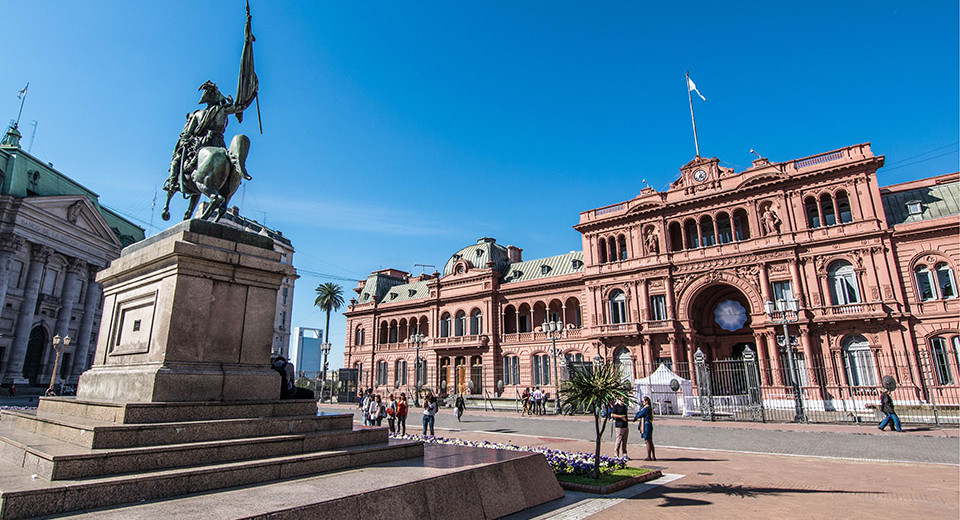
The Casa Rosada (The Pink House)
The Casa Rosada, in English the Pink House, is the Argentine’s Government house and the place where many of the major historic events of this country took place. Located at the main plaza, Plaza de Mayo , the building is a must-see landmark of the city.
Continue reading
- Calafate (1)
- Iguazu Falls (1)
- Mendoza (1)
- Barracas (1)
- Belgrano (2)
- Caballito (2)
- Chacarita (1)
- Colegiales (2)
- Downtown (2)
- La Boca (3)
- Palermo (8)
- Puerto Madero (3)
- Puerto Madero (1)
- Recoleta (7)
- San Telmo (4)
- San Telmo (3)
- Villa Crespo (2)
- Buenos Aires Tips (53)
- Calendar (8)
- Cultural Agenda (2)
- Ephemeris (13)
- Free BA (2)
- Free Tours on your own (4)
- Getaways (2)
- Getting to Buenos Aires from the Airport (1)
- History (2)
- How to get around BA (1)
- Palermo (3)
- Personalities (4)
- Planetarium (1)
- Rent a Car (1)
- San Telmo Market (1)
- Street Art (1)
- Teatro Colon (1)
- Uncategorised (1)
- Walk the city (7)
- Walks Through BA (5)
- Best Things to do (16)
- CCK Cultural Center (1)
- Day Trips from BA (4)
- Football Tickets (1)
- Markets in Buenos Aires (1)
- Palermo Parks (5)
- Tigre Day Trip (2)
- Walk the city (2)
- Desserts (2)
- Empanadas (1)
- Ice Cream (1)
- Steak Houses (2)
- Vegetarian (1)
- Wine Tasting (1)
- Ecological Reserve (2)
- Graffiti (3)
- Museums (15)
- Pink House (1)
- Where to stay in BA (2)
Recent Posts
- Navigating the Riachuelo
- Hop on hop off buenos aires
- Distrito Arcos
- Memory and Human Rights Museum ex ESMA

Buenos Aires
Travel guide.
- Things to Do
- Best Hotels
- Neighborhoods Worth a Visit
- The Palermo Gardens Complex & Zoo
- Best Restaurants
- Best Nightlife
- Planning a Trip
- Organized Tours
- Walking Tours
- Active Pursuits
- Spectator Sports
- Suggested Itineraries
Buenos Aires › Attraction
Casa rosada & the presidential museum.
Perhaps the most photographed building in Buenos Aires, the Casa Rosada is the main presence on the Plaza de Mayo. The Argentine president does not live here, contrary to what many tourists think, but she does work here. (She lives in a mansion in Los Olivos, a suburb north of the city.) It is from a balcony of the north wing of this building that Eva Perón addressed adoring crowds. Hoping for star-quality glamour, former President Carlos Ménem allowed Madonna to use it for the 1996 movie Evita, to the shock of many Porteños. Most Argentines, however, associate the balcony with the announcement of military dictator Leopoldo Galtieri's ill-fated war in 1982 against the United Kingdom over the Falkland Islands, known here as the Islas Malvinas. Girl power aside, the color pink has nothing to do with the female president. Two theories explain the color. One is political: At the time of its construction in the late 1800s, two warring parties, one represented by the color red, the other by white, are said to have created a truce by painting the building a color combining both shades. The other, rather revolting theory is more practical: In days past, the building was painted with cow blood that later dried in the sun to a deep pink color. At night, hot pink floodlights now also illuminate the building.
You can watch the changing of the guard in front of the palace every hour on the hour. In the back of the building, you'll find the Presidential Museum, with information on the history of the building and items owned by various presidents over the centuries. Portions of the museum extend underground into basements of former buildings, including a 2011 extension to house a mural by Mexican artist José David Alfaro Siqueiros. Make sure to step outside to look at excavations on the Customs house and port area, which existed along the Río de la Plata at this point until landfill projects pushed the shore farther east. The Casa Rosada is now also open to the public on weekends, with free tours on the hour Saturdays and Sundays from 10am to 6pm. If you're going on one, bring identification and expect to have personal items X-rayed to help ensure the security of the president. The tour will take you through ornate chambers, many overseen by marble busts of past presidents. You even get to stand on Evita's balcony and tell Argentina not to cry for you.
Note : This information was accurate when it was published, but can change without notice. Please be sure to confirm all rates and details directly with the companies in question before planning your trip.

- All Regions
- Australia & South Pacific
- Caribbean & Atlantic
- Central & South America
- Middle East & Africa
- North America
- Washington, D.C.
- San Francisco
- New York City
- Los Angeles
- Arts & Culture
- Beach & Water Sports
- Local Experiences
- Food & Drink
- Outdoor & Adventure
- National Parks
- Winter Sports
- Travelers with Disabilities
- Family & Kids
- All Slideshows
- Hotel Deals
- Car Rentals
- Flight Alerts
- Credit Cards & Loyalty Points
- Cruise News
- Entry Requirements & Customs
- Car, Bus, Rail News
- Money & Fees
- Health, Insurance, Security
- Packing & Luggage
- -Arthur Frommer Online
- -Passportable
- Road Trip Guides
- Alaska Made Easy
- Great Vacation Ideas in the U.S.A.
- Best of the Caribbean
- Best of Mexico
- Cruise Inspiration
- Best Places to Go 2024
Frommer's Star Rating
About our system.
Frommer's only recommends things we think you will enjoy and that will make your trip both authentic and unforgettable. Our experts personally appraise each choice in terms of their overall enthusiasm for it.
Our star system does not denote hotel amenities but it does denote the level of our approval. A place with one star is worth a look—after all, it made the list. A rating of two stars means it's excellent, and three stars is the highest praise we give.
Don’t cry for me…
Casa Rosada: The Argentinian Government let Madonna film there, it’s been the scene of military coups and now you can glimpse into the life of the President.
Written by Michael Turtle
Michael Turtle is the founder of Time Travel Turtle. A journalist for more than 20 years, he's been travelling the world since 2011.
Michael Turtle is the founder of Time Travel Turtle and has been travelling full time for a decade.
Updated: August 24, 2023
Casa Rosada, Buenos Aires, Argentina
In the mid-1990s, hoping it would bring great fortune and fame to the country, the Argentinian Government allowed Madonna stand on the balcony of the Presidential Palace in Buenos Aires to film the scene from ‘Evita’ that would define the movie.
Of course, the balcony scene was a stand-out partly because the rest of the film was such a dog that it wouldn’t look out of place running with the rabid animals of this city. But there is more to it than that.
There was something inspiring about the image of Eva Peron, proud and optimistic, speaking to the masses below in a way that politicians had never done before in Argentina.
Still to this day, Eva Peron and her husband Juan are an extremely divisive topic in South America.
Where some people see the saviours of the working class, some see a thuggish dictator and trashy power-hungry social-climber.
When Madonna stands on the balcony and asks Argentina not to cry for her, she is rejecting the views of the latter.
She pleads with the people not to believe that she invited in fame and fortune, even though it seemed to the world it was all she desired.
Regardless of political sympathies or opinions, it’s with Evita firmly in the front of mind that most visitors enter the Presidential Palace in Buenos Aires.
It’s known as the Casa Rosada, which quite literally means ‘Pink House’, making it sound a little bit camper than Washington DC’s equivalent.
If there were any doubts about whether it was going to be kitsch, they’re quickly dispelled inside by the stain-glass windowed gallery and huge black statues of horses scattered throughout the building.
It’s grand in scale, but in some ways appropriate for what it represents. Over the decades of Argentina’s modern history there has often been a degree of excess from the aristocrats while the rest of the population suffers from economic or political torment.
Today, homeless families sleep under makeshift tents in the plaza outside the Casa Rosada while, inside, wooden angels blow trumpets towards the bronze coat of arms; grey vein marble stairs lead visitors between the floors; and a floor of English ceramic surrounds four Yatay Palm trees in the courtyard garden.
The palace was declared a National Historical Monument in 1942, exactly ten years before Eva Peron died and became as important a symbol for the Argentinians as the building from which she gave her addresses. But, like much in Argentinian politics, not everything is as it seems.
Those pink walls contain more than just the aristocratic displays of wealth – for behind the façade are the secrets of the powerful.
Evita herself used her position as First Lady to change her birth certificate to make herself three years younger and for it to read that she was born to married parents, rather than born illegitimate.
And the fall of many a government has been plotted in the building, although the hall of presidential busts today doesn’t include some leaders who were installed through military coups.
When the United Kingdom went to war with Argentina over a couple of little islands in the South Atlantic ocean, the song Don’t Cry For Me, Argentina was banned from British radio stations.
It may have seemed like a simple patriotic move (even though, of course, it was written by two Englishmen) but it may also have been wise.
During her time in power, Evita was given the official title of “Spiritual Leader of the Nation” and some Latin American historians claim she is, to many families, the second most important woman only to the Virgin Mary.
She stood on that balcony at the Casa Rosada and made her speeches and for the masses who came to listen she was the face of Argentina. To tour the building, (which you can do only on the weekends), is to see the body… perhaps even the brain of the country.
But not the face. The face was Evita’s and the country’s heart was hers.
THE BEST ACCOMMODATION IN BUENOS AIRES
If you stay close to the city centre of BA, you’ll be near many of the main sights and have easy access to other neighbourhoods.
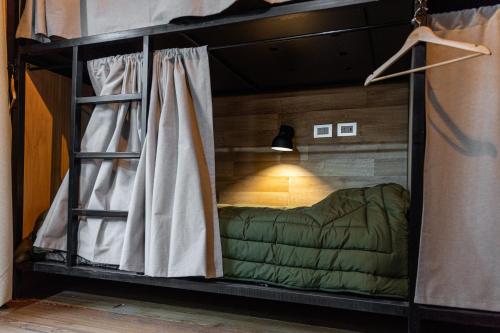
For a backpacker option, Che Juan Hostel is modern and comfortable with good privacy.
With great value and a central location, River Hotel is a good option if you’re on a budget.

For true style, I would recommend BE Jardin Escondido , which is where Francis Ford Coppola stays.
And when it comes to the top end, the Palacio Duhau – Park Hyatt is the ultimate in luxury!
More stories about Argentina
- Visiting Casa Rosada in Buenos Aires
- A guide to visiting Iguazu Falls
- What I learned at Che Guevara's house
- The incredible Ischigualasto National Park
- Taking a wine tour in Mendoza
- The millions of penguins at Punta Tombo
- Why hiking in El Chalten is so special
- How to visit the Perito Moreno Glacier
- All of the World Heritage Sites in Argentina
14 thoughts on “Don’t cry for me…”
Its a nice house, but I couldn’t help but think it could be a little more beige. AA would view again.
At night they shine pink lights onto the building. There is no ambiguity then about what colour it is!
You might want to check out the Evita Museum. I wasn’t expecting much, but I actually enjoyed it. There is a certain day of the week it is cheaper I think.
Cool, thanks. I’ll check it out. It’s such an interesting part of Argentina’s history.
This was a fascinating read. I do indeed have some pretty fixed opinions of the Perons (more in the power-hungry end of the spectrum) but reading this — and looking at your gorgeous photos — has left me curious and wanting to learn more. Great job!
You can certainly go to the Casa Rosada, get the tour, and just enjoy the building for what it is. But it adds another level to the visit if you start to think about some of the things that have happened in there.
hi mike wow you really have the gift of speach but i have just one thing to add. Peron was not a dictator he was elected president legally and is the only person who has been elected president for three times. he was between two dictatorships but was not a dictator. saludos
Good point! By using that word I was trying to say that some people have accused him of ‘acting’ like a dictator. But it’s definitely worth remembering that, despite some ill feeling in Argentina towards Peron, he was indeed democratically elected each time. Thanks for the clarification, Gabriel!
The Pink House in Buenos Aires is the only presidential palace I’ve seen in my entire life that is uniquely designed not only basing from its exterior and interior architecture, but also from its color. Quite unusual, but using pink as the overall color of the palace makes it magnificent.
It’s particularly pink when they shine the lights on it at night!
Very cool blog. I’m happy I stumbled upon it!
Thanks, Franco. Nice to have you on board!
Curious about the comment that the song from Evita was banned from British Radio stations during the war with Argentina. I cannot confirm this, where did you get the information! There doesn’t even seem to be a way of banning it (other than the owner of the radio station deciding not to broadcast it). Curious because the tune was played on television when the British were sailing off to the war!
Hey David. Good question. I got the information here: http://www.rocklistmusic.co.uk/banned.html but I would be happy to be corrected if there’s some different information. I also read during my research the song was often played ‘ironically’ when the British troops were leaving, which would explain that.
Leave a comment Cancel reply
Find me on the socials:, subscribe for news and deals:.
Similar posts
Botanical garden (buenos aires), hotel plaza, monument of tango, basilica of santo domingo, torre monumental, puerto madero, tres de febrero park, congress area, last updated posts, how to grow a rose from the seeds from china, how to sew shorts with your own hands, how to get rid of the smell of urine on the couch, bella hadid became one of the models of victoria's secret, places of power, shchi with mushrooms and fresh cabbage, the crisis of 30 years, treatment of mastitis during breastfeeding, dyskinesia of bile ducts in children, sexy swimsuits, aquamaris for newborns, the norm of pressure in children, winter knee socks, than to erase a membrane, argentina - traditions and customs, summer long dresses for full women.
- Yuzhno-Sakhalinsk Airport
Description
Yuzhno-Sakhalinsk Airport is an airport used by private jets in Yuzhno-Sakhalinsk , Russia. It has a maximum runway length of 3,400 meters. There is only one runway in total at the airport.
Yuzhno-Sakhalinsk Airport, also called Khomutovo, is an airport in Yuzhno-Sakhalinsk, on the Russian island of Sakhalin. The airport was established in 1945 as a military airfield. With currently one 3,400 m concrete runway, one passenger terminal, two cargo terminals and 16 aircraft stands, Yuzhno-Sakhalinsk Airport is the largest airport in Sakhalin Oblast.
Sometimes referred to as UHSS - its ICAO code - on private jet quotes, for example, it can also be called UUS - its IATA code name. Both these shorthands are used by aircrafts to refer to the airport.

Private Jet Flights
Here's just a few flights Central Jets users have requested from this airport in the past. Request a jet to your own destination to get an instant quote today.
- Latitude: 46.886944
- Longitude: 142.721944
- Altitude: 18 meters
- Runway length: 3,400 meters
- Number of runways: 1
- City: Yuzhno-Sakhalinsk
- Region: Sakhalin Oblast
- Country: Russia
Russia Travel Blog | All about Russia in English
- About our blog
- RussiaTrek.org
Sidebar →
- Architecture
- Entertainment
- RussiaTrek.org News

- Leave a tip to support us
- Support RussiaTrek.org via Boosty
- Support RussiaTrek.org via Hipolink
- Travel Guide to Ukraine
- Comments RSS
← Sidebar
Yuzhno-Sakhalinsk – the view from above
No comments · Posted by Sergei Rzhevsky in Cities , Travel
Yuzhno-Sakhalinsk is a city with a population of about 200 thousand people located in the southeastern part of Sakhalin Island in the Far East of Russia , the capital of Sakhalin Oblast .
It is the sixth largest city in the Russian Far East, in which Russian and Japanese cultures are closely intertwined. Here you can often see old Japanese buildings and monuments. The distance from Yuzhno-Sakhalinsk to Moscow , if flying by plane, is 6,640 km and 9,280 km (by car). Photos by: Slava Stepanov .
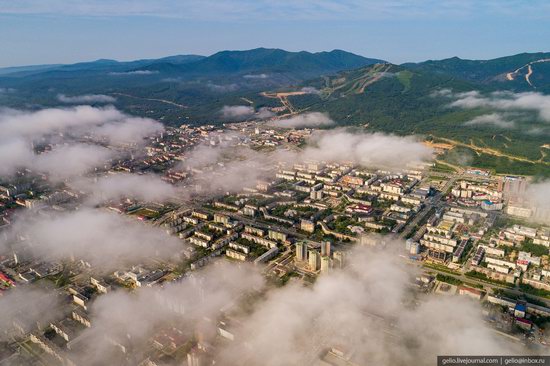
Victory Square – one of the main squares of Yuzhno-Sakhalinsk.
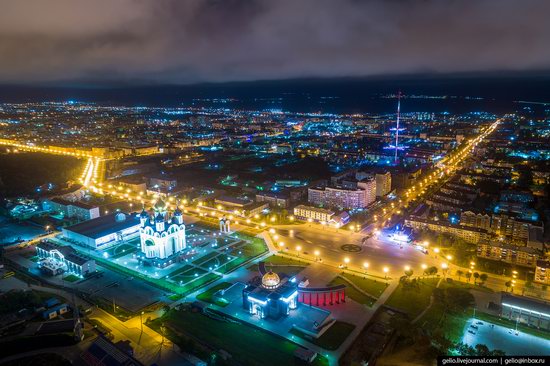
Cathedral of the Nativity.
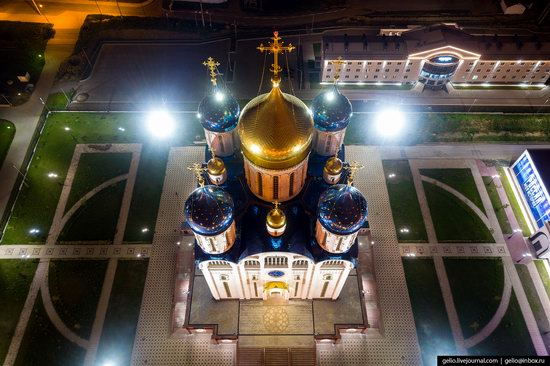
About one third of the total population of Sakhalin Island lives in Yuzhno-Sakhalinsk.
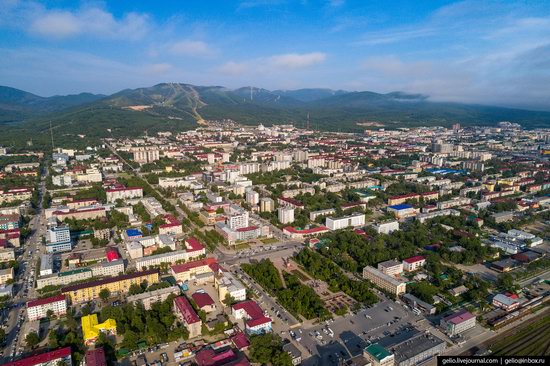
Lenin Square.
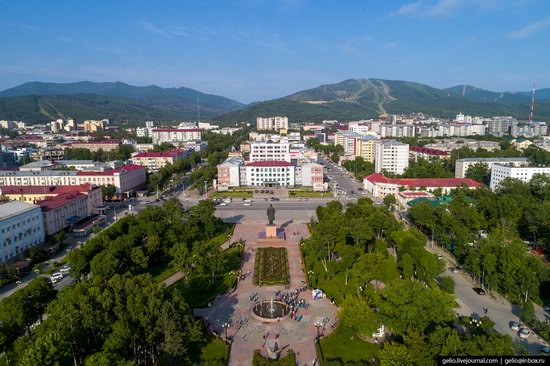
Sakhalin Regional Museum of Local Lore housed in a Japanese building constructed in the Imperial Crown Style in 1937. This is the only such building on Sakhalin and throughout Russia.
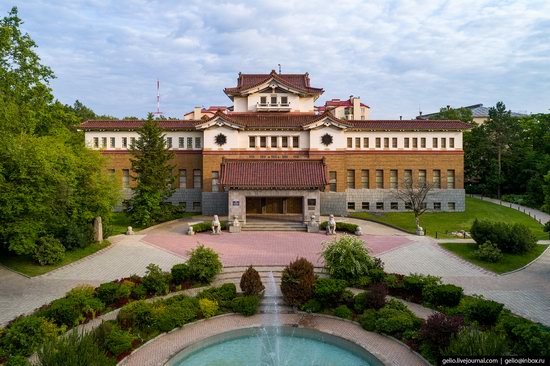
The climate in Yuzhno-Sakhalinsk is quite mild, there are no severe frosts in winter, and heat in summer. The coldest month is January with an average temperature of about minus 12 degrees Celsius. The warmest month is August (plus 17 degrees Celsius). Clear and dry weather sets in early September – the best time to visit Sakhalin.
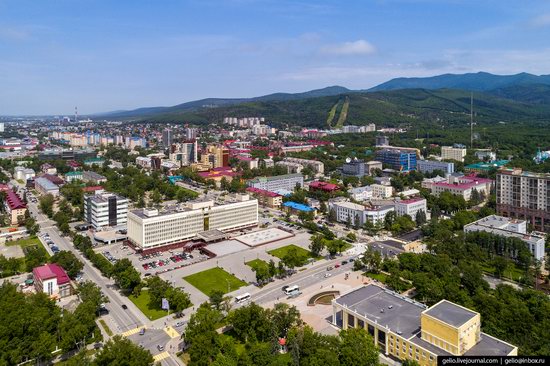
House of Government of Sakhalin Oblast.
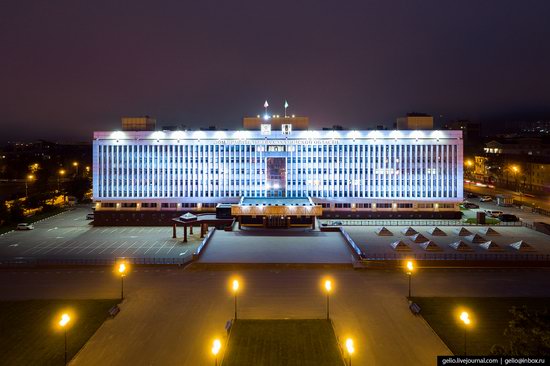
“Chekhov Center” – the only drama theater in Sakhalin Oblast.
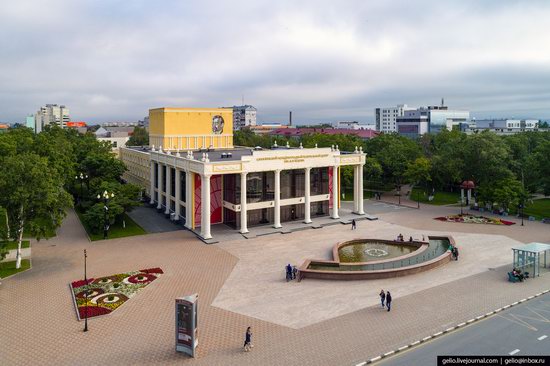
Sakhalin residents often call the rest of Russia “the mainland.” You can get out of the island by plane, ferry, or other water transport.
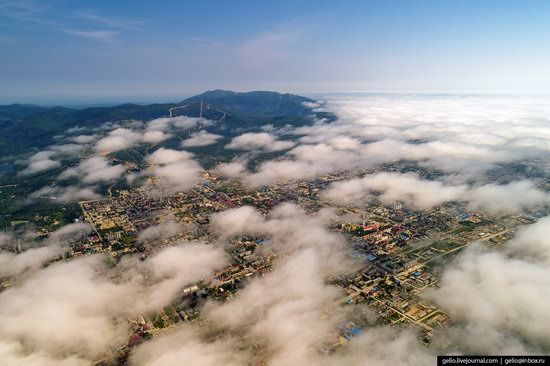
Park named after Yuri Gagarin.
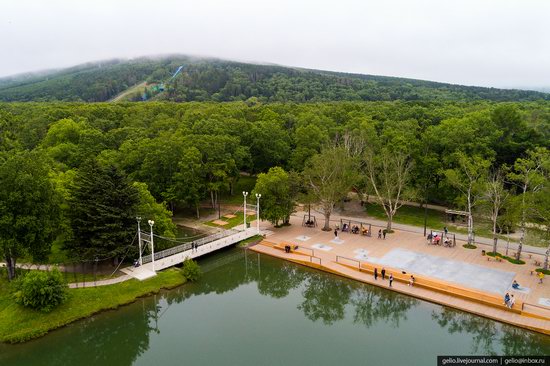
Roman Catholic Church “Parish of St. James”. In addition to divine services, organ and violin concerts are held here.
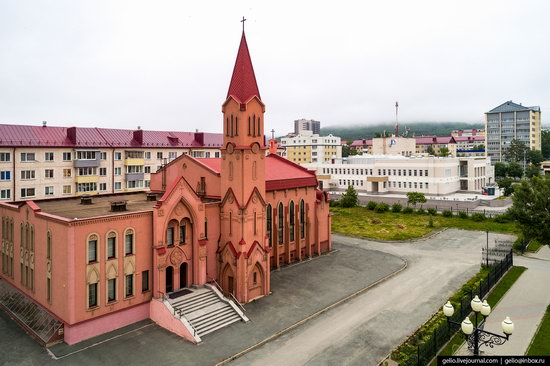
Museum of Railway Technology.
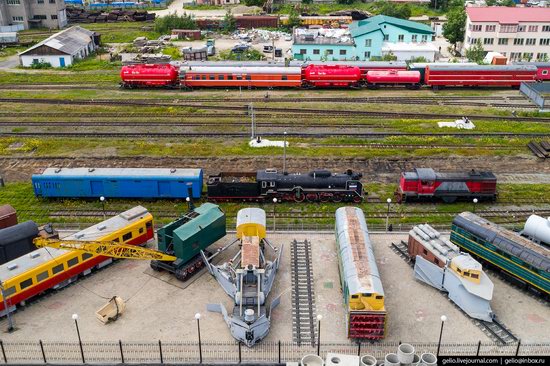
Church of the Resurrection.
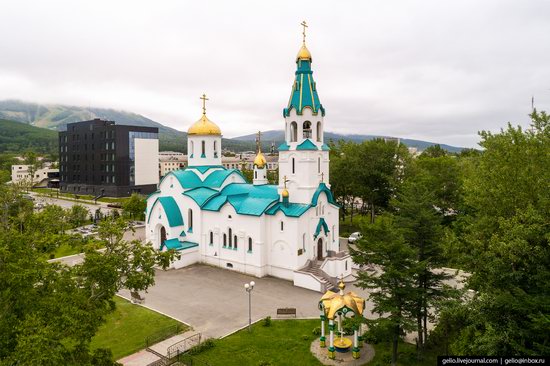
Stadium “Cosmos” in Gagarin Park.
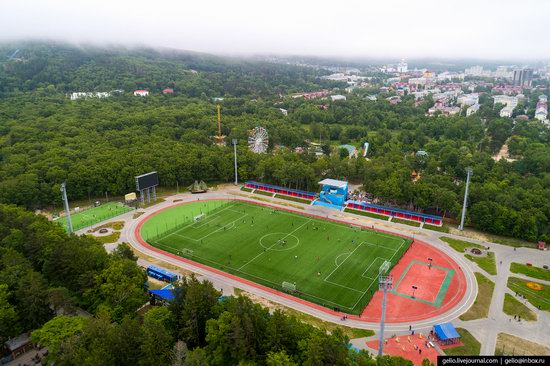
Stele “Cities of the Sakhalin Region”.
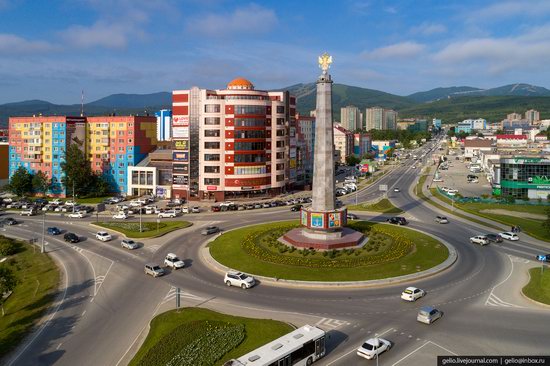
Tags: Sakhalin oblast · Yuzhno-Sakhalinsk city
You might also like:
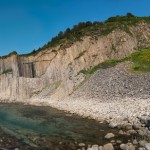
Tomsk – the view from above
Russia and Alaska Among the Best Winter Cruises and Destinations >>
No comments yet.
Leave a reply.
XHTML: You can use these tags: <a href="" title=""> <abbr title=""> <acronym title=""> <b> <blockquote cite=""> <cite> <code> <del datetime=""> <em> <i> <q cite=""> <s> <strike> <strong>
- August 2024
- February 2024
- January 2024
- December 2023
- November 2023
- October 2023
- September 2023

IMAGES
COMMENTS
Dominating the Plaza de Mayo, the Casa Rosada - or pink house - is the seat of the Argentine national government and houses the president's office. Scene of much of the city's history, it was from the balconies of the Casa Rosada that Juan and "Evita" Perón addressed the masses during the late 1940s and early 1950s. Visits.
Tours of the Casa Rosada. 50 Balcarce, Mirocentro. Tel: 4344-3802 / 4344-3805. * Editor's Update: Until the last change of administration in Argentina, guests could make free reservations through https://visitas.casarosada.gob.ar/ but the website isn't working. In the meantime, check out some other popular Buenos Aires tours.
The Casa Rosada, in English the Pink House, is the Argentine's Government house and the place where many of the major historic events of this country took place. Located at the main plaza, Plaza de Mayo, the building is a must-see landmark of the city. This eclectic Presidential Palace of Italian-French architecture has been the work place of the Argentine President since the late 19th century.
An overview of how to get your free ticket: Two weeks before visiting the registration opens. This link. Tours only on Saturdays. English tour at 12h30. Registrate with your passport! Based on your passport they will do a check in the police databases. Print your tickets. Bring your passport when you go to visit Casa Rosada.
La Casa Rosada or The Pink House, also known as Casa de Gobierno - House of Government, is a must-visit tourist spot in Buenos Aires, Argentina. It is the executive house and also the office of the Argentinian president. It is not the house of the President: the President's official residence is at the Quinta de Olivos.
Visit to the. Casa Rosada. We toured around the rooms and hallways of the magnificent Pink House. At the time officials do not work, the Casa Rosada (the "Government House") is open to public tours. The Grenadiers do not guard the entrance any longer; they work as tourist guides instead. On a sunny Sunday morning, once we got through the ...
The Casa Rosada at the eastern extreme of the Plaza de Mayo is the seat of the country's government, where the President and her staff work. On weekends, you can tour the building for free. Unlike America's White House, the President doesn't live inside the Casa Rosada. But very much like America's Jennifer Lopez, the building is most ...
Here's everything you need to know before visiting the Casa Rosada. One of the best ways to discover the secrets of the Casa Rosada is by taking a guided tour. Tours are offered in Spanish and English, are free of charge and can be reserved by visiting the website. An experienced guide will take you around the public areas of the presidential ...
2. Tour the President's Pink House: Casa Rosada Casa Rosada. The most famous of Plaza de Mayo's many fine buildings, Casa Rosada was built in the mid-1800s and stands on a site known to have been occupied by an old customs house and fort dating back to the 16th century. Literally translated as the "Pink House," Casa Rosada — officially referred to as Casa de Gobierno or the government house ...
History of Casa Rosada. The area on which Casa Rosada is located was once by the sea and in the late sixteenth century was the site of the Royal Fort of San Juan Baltasar de Austria built under the orders of Don Juan de Garay. It underwent a variety of changes: in 1713, the fort was demolished and rebuilt as the Castillo de San Miguel, the ...
Oct 2019. Built between 1862 and 1885. Casa Rosada (Pink House) is the Argentine Presidential Palace. No longer used as a residence (the Presidential Residence is located in the suburb of Olivos), the Pink House houses the presidential offices and ceremonial rooms. Evita Peron addressed the crowds from the balcony.
Dominating the Plaza de Mayo, the Casa Rosada - or pink house - is the seat of the Argentine national government and houses the president's office. Witness to much of the city's history, it was from the balconies of the Casa Rosada that Juan and "Evita" Perón addressed the masses during the late 1940s and early 1950s. The Casa Rosada was ...
The Casa Rosada, also called the Pink House, is a historical and iconic landmark in Buenos Aires. It serves as the seat of the Argentine national government and is a symbol of Argentine politics. The Casa Rosada offers free guided tours in English and Spanish, allowing visitors to explore its rich history. The iconic pink color of the building ...
Visit Buenos Aires' iconic pink governmental palace. 22,5° What to do Guided tours ; Itineraries ; Art, culture and tango ... Casa Rosada. Visit Buenos Aires' iconic pink governmental palace. ...
The Casa Rosada (Spanish pronunciation: [ˈkasa roˈsaða]), literally the Pink House, is the president of the Argentine Republic's official workplace, located in Buenos Aires.The palatial mansion is known officially as Casa de Gobierno ("House of Government" or "Government House"). Normally, the president lives at the Quinta de Olivos, the president of Argentina's official residence, located ...
The Casa Rosada (The Pink House) The Casa Rosada, in English the Pink House, is the Argentine's Government house and the place where many of the major historic events of this country took place. Located at the main plaza, Plaza de Mayo, the building is a must-see landmark of the city. Continue reading. Daily FREE TOURS. La Boca.
Casa Rosada public tours Sat-Sun 10am-6pm Transportation Metro: Plaza de Mayo Phone 11/4344-3802 Prices Free admission. Perhaps the most photographed building in Buenos Aires, the Casa Rosada is the main presence on the Plaza de Mayo. The Argentine president does not live here, contrary to what many tourists think, but she does work here.
Casa Rosada, Buenos Aires, Argentina. In the mid-1990s, hoping it would bring great fortune and fame to the country, the Argentinian Government allowed Madonna stand on the balcony of the Presidential Palace in Buenos Aires to film the scene from 'Evita' that would define the movie. Of course, the balcony scene was a stand-out partly ...
Address: Argentina, Buenos Aires, Balcarce 50 Phone: +541143443600 Website: www.casarosada.gov Architectural style: neoclassicism Project Author: Francesco Tambourini Architect: Carlos Kilberg Years of construction: 1882-1898 Casa Rosada or the Pink House is the residence of the current president of Argentina , where his official study is located.
Yuzhno-Sakhalinsk, also spelled Uzno-Sakhalinsk and previously known in Japanese as Toyohara, is the largest city and capital of Sakhalin Oblast, in the Russian Far East, with a population of around 173,000. Photo: Alkhimov Maxim, CC BY-SA 4.0. Photo: Wikimedia, CC BY-SA 2.0. Photo: Maarten, CC BY 2.0. Ukraine is facing shortages in its brave ...
Book private jets direct from owners and operators with Central Jets and save on any redundant middleman fees. Subscribe at €199 per month and book as many jets as you want at direct prices through our 24/7 concierge team.
Yuzhno-Sakhalinsk - Overview. Yuzhno-Sakhalinsk is a city located in the southern part of Sakhalin Island in the Far East of Russia, the administrative center of Sakhalin Oblast. The population of Yuzhno-Sakhalinsk is about 201,700 (2022), the area - 164 sq. km. The phone code - +7 4242, the postal codes - 693000-693904.
The climate in Yuzhno-Sakhalinsk is quite mild, there are no severe frosts in winter, and heat in summer. The coldest month is January with an average temperature of about minus 12 degrees Celsius. The warmest month is August (plus 17 degrees Celsius). Clear and dry weather sets in early September - the best time to visit Sakhalin.